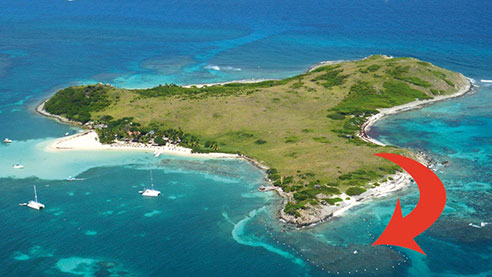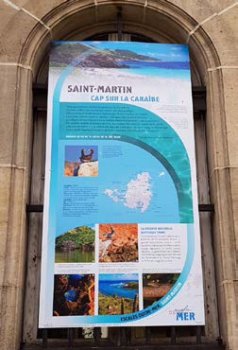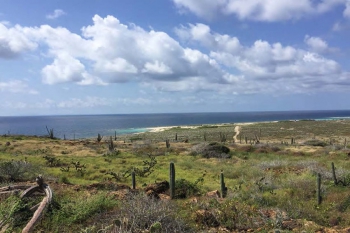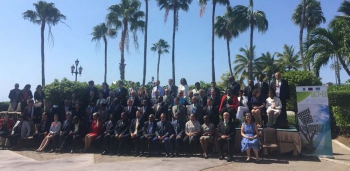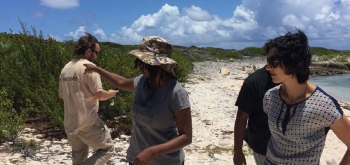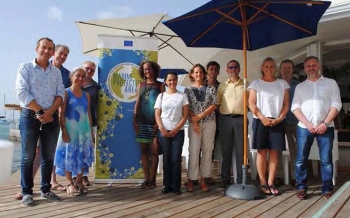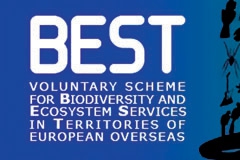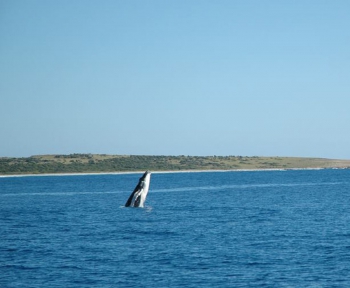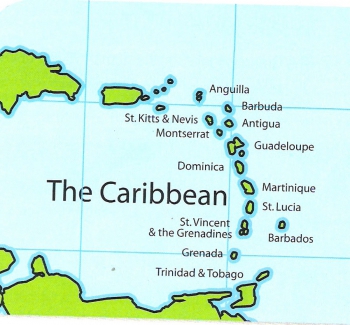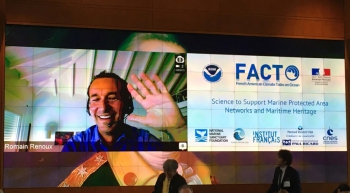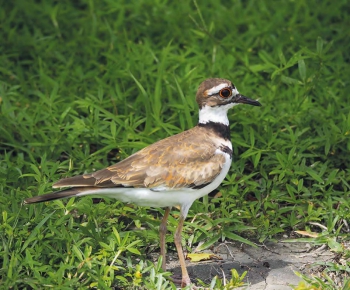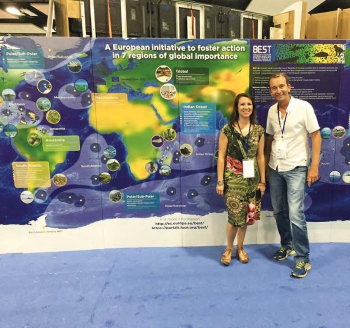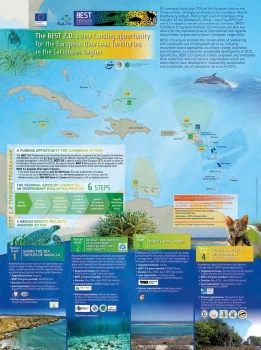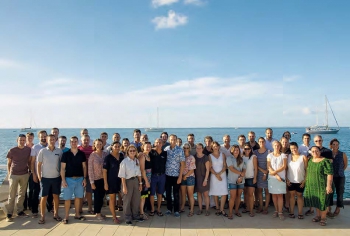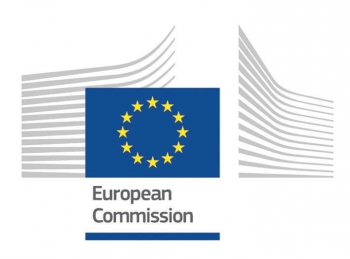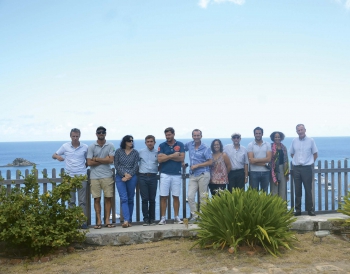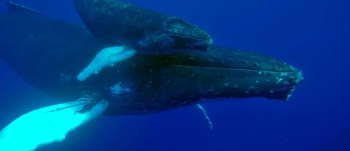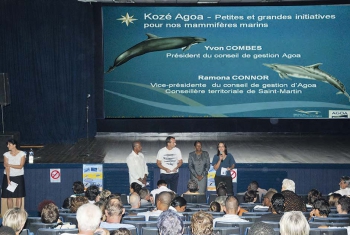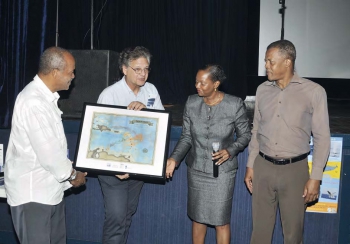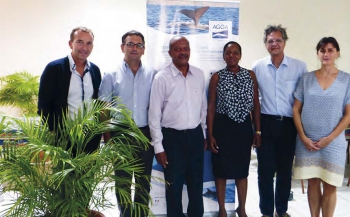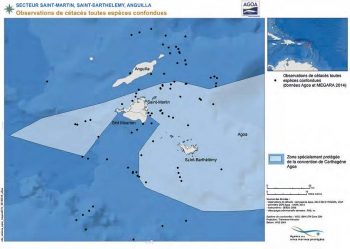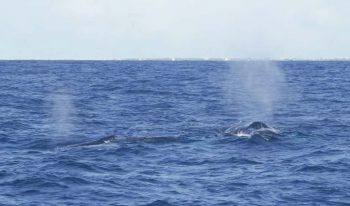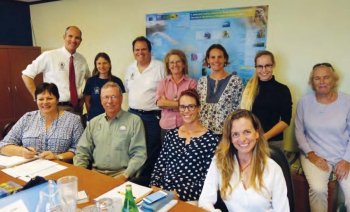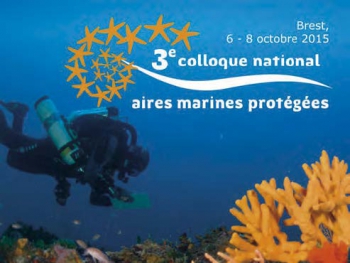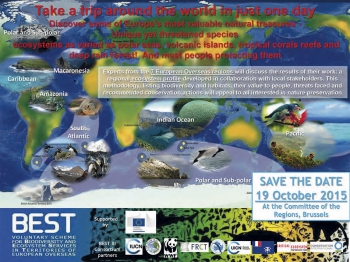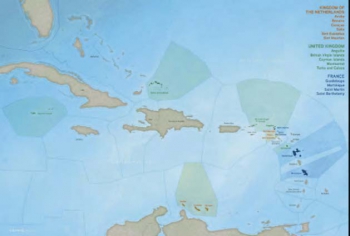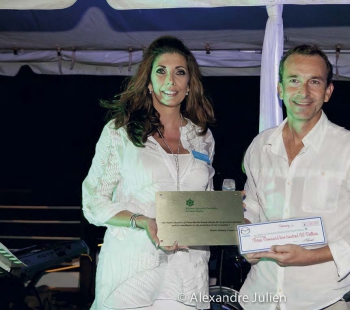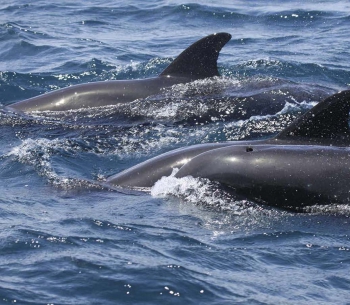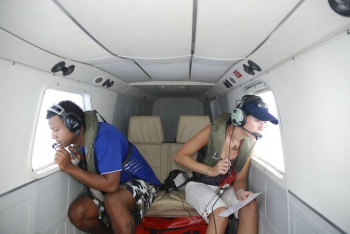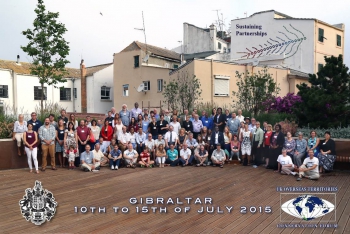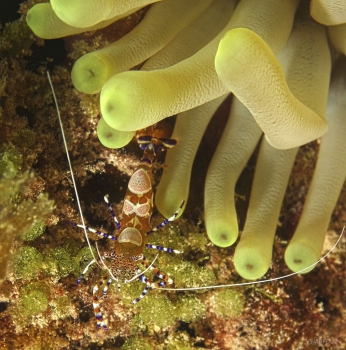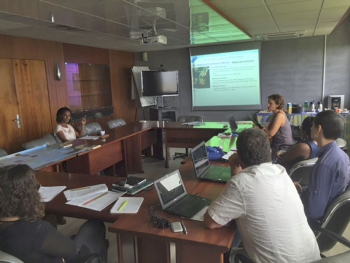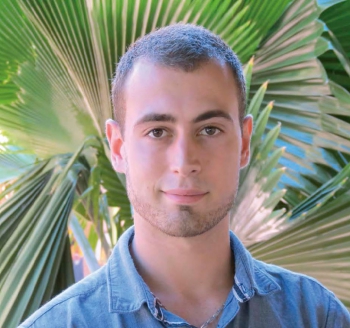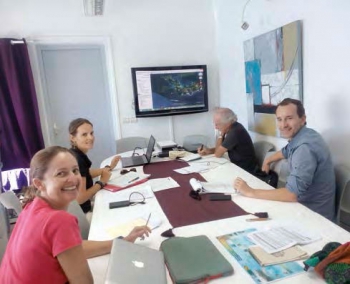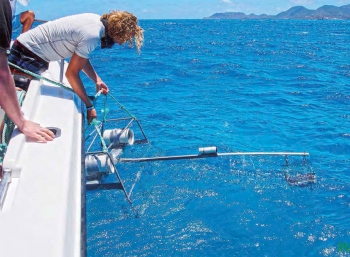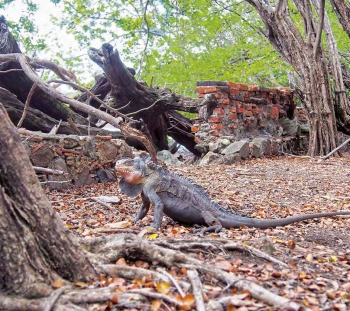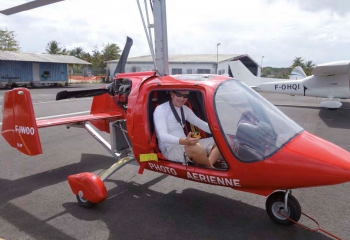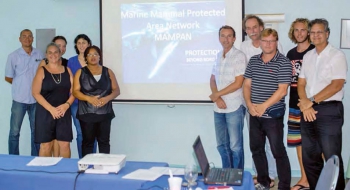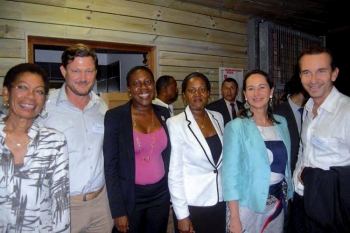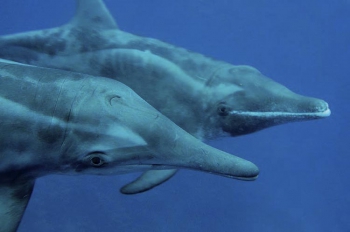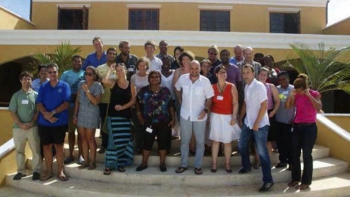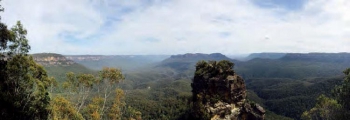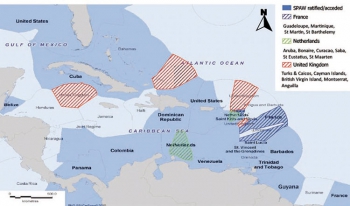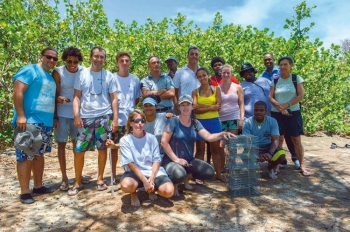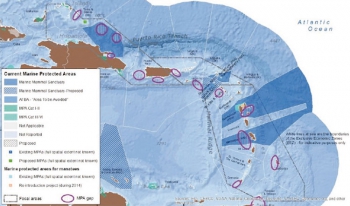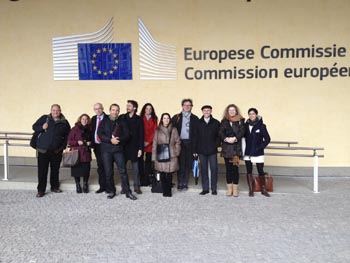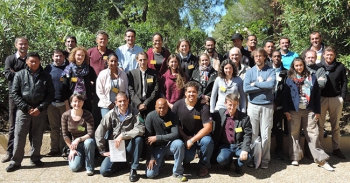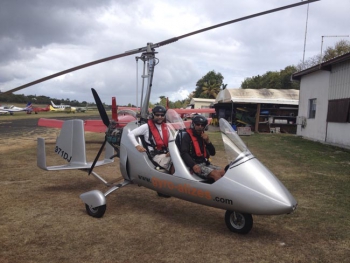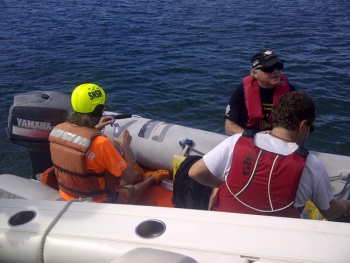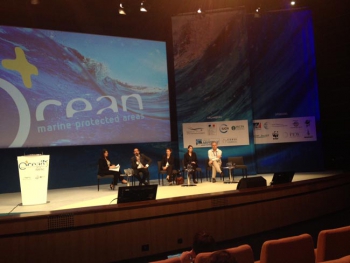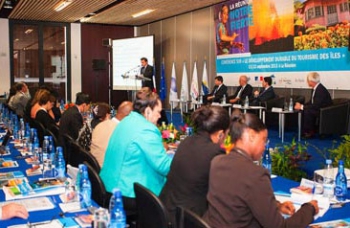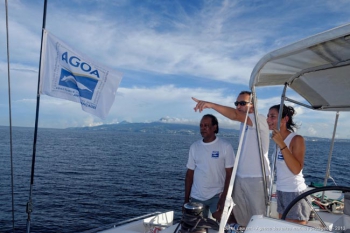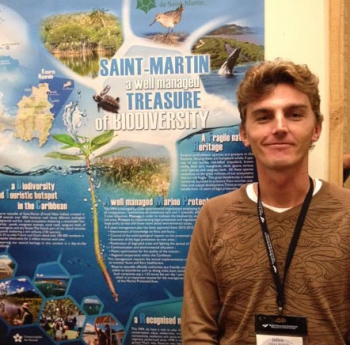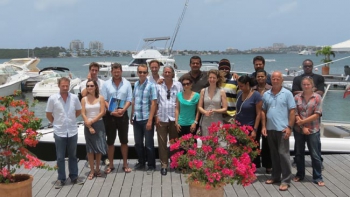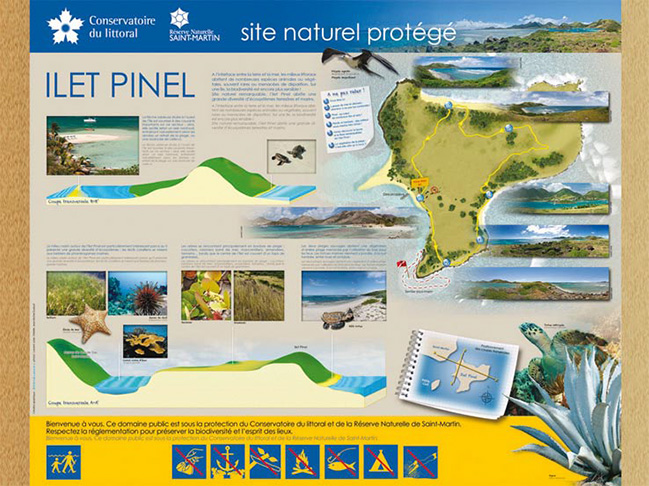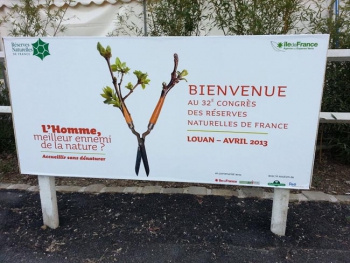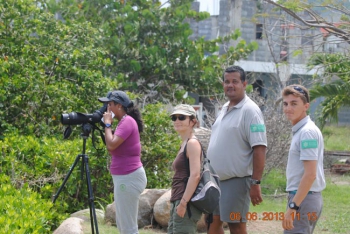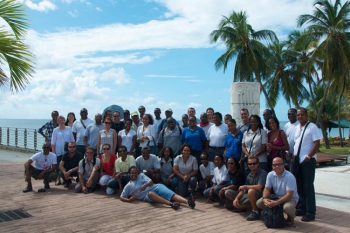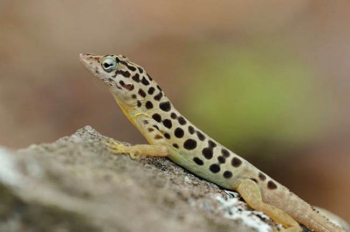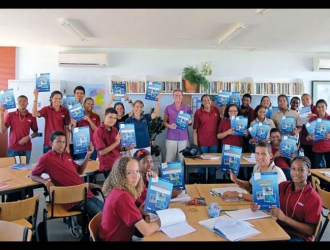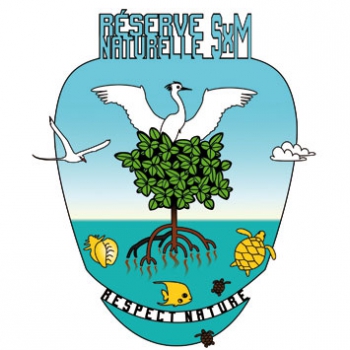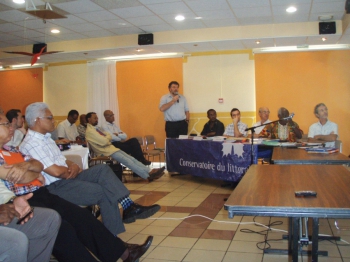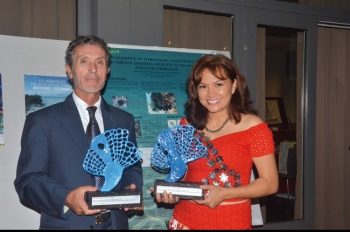Overseas Minister Annick Girardin inaugurated the exhibit, Overseas Locales (Escales Outre- Mer), on November 30 at the Ministry in Paris, accompanied by the media, school groups, and the Réserve Naturelle de Saint-Martin, represented by director Nicolas Maslach. He was able to speak with the minister for several minutes about the impact of Irma on the Réserve Naturelle and the recovery activities put in place in the months after the hurricane and those to follow. The exhibit, fruit of a collective effort throughout the overseas areas, is intended to move around France and Overseas territories for several years. There are 50 photographs that illustrate for the first time the biodiversity of the 13 overseas territories –including Saint Martin– that comprises 80% of French biodiversity. In addition to the discovery of this extraordinary natural heritage –fauna, flora, endemic and endangered species– the exhibit puts an accent on protected zones, where the primary issue is how to maintain the biodiversity. The goal of the photographers and the sponsors: to build wider awareness for the general public, including school children, and share the importance of preserving our natural overseas richness, and on a larger scale, the eco-systems of our entire planet.
Reinforcement On A Regional
Reinforcement On A Regional
Reinforcement On A Regional
The underwater study for the Réserve Marine de Saint-Barth, which was scheduled for December 7-9, was cancelled due to bad weather conditions. The Réserve de Saint-Martin, representatives of the Réserve de Petite-Terre and of CREOCEAN had come to lend a hand to the Territorial Environmental Agency of Saint Barth, as part of their annual cooperation linked to the underwater study of marine parks. The divers tried, but without success, to unroll 150 meters of graduated ribbon along the transect. Explication: the strong swells present around the Northern Islands at the end of the year contributed to the movement of a large quantity of sediment displaced by Irma. Suspended in the water again, it caused a lot of turbidity, but also marks a progressive restructuration of the underwater milieu, under the effect of the swells and currents, towards a return to normal. The study has been postponed until February 2018.
The underwater study for the Réserve Marine de Saint-Barth, which was scheduled for December 7-9, was cancelled due to bad weather conditions. The Réserve de Saint-Martin, representatives of the Réserve de Petite-Terre and of CREOCEAN had come to lend a hand to the Territorial Environmental Agency of Saint Barth, as part of their annual cooperation linked to the underwater study of marine parks. The divers tried, but without success, to unroll 150 meters of graduated ribbon along the transect. Explication: the strong swells present around the Northern Islands at the end of the year contributed to the movement of a large quantity of sediment displaced by Irma. Suspended in the water again, it caused a lot of turbidity, but also marks a progressive restructuration of the underwater milieu, under the effect of the swells and currents, towards a return to normal. The study has been postponed until February 2018.
Enact a protected marine zone. That was the challenge met by the Dutch Island of Aruba with the creation of its new Marine Park. Located on the edge of the most recently protected coastal areas on this highly touristic island, the Aruba Marine Park is a continuation of the Arikok National Park, the Spanish Lagoon —wetlands with RAMSAR classification— and Mangel Halto Beach. The project, led by the Department of Nature and Environment, an official government agency in Aruba, benefits from financing from the European BEST program for Overseas Territories, which provided 300,000 Euros out of a total budget of 350,000 Euros from May 2016 through April 2019. Aruba has also received funding from BEST to define the perimeter of this zone intended to protect the island’s marine biodiversity, and to develop its management structure. Romain Renoux, coordinator of the BEST program for the Caribbean islands, met with the local creators of the Marine Park when he visited Aruba on February 20-22, in order to check in with them on the progress of their project, identify any potential difficulties, and be brought up to date on their early results. Coming from Saint Martin, where the Réserve Naturelle was created in 1998, he was able to explain to his hosts about the work accomplished, without hiding the obstacles they met with before the park was completely accepted by the population.
Every year, the European Union invites overseas countries and islands (PTOM) from around the world to a large forum designed to review the support that Europe brings —and could bring— to these territories. The most recent forum was held on February 23-24, 2017 in Aruba and allowed the delegations that came from the Atlantic, the Caribbean, the Pacific, the Indian Ocean, and even the Antarctic, to meet with representatives of the European Commission and four of its member states (Denmark, France, Holland, and the United Kingdon). Romain Renoux, coordinator of the European BEST project for the Caribbean island, was there of course, and was able to highlight concrete examples of biodiversity preservation in the 12 overseas islands in the Caribbean, all of which were represented
Two projects presented by Anguilla were selected by the BEST program and are currently being developed. Romain Renoux visited his island neighbors on April 11-12, 2017, along with Elise Queslin, director of BEST at Car-Spaw, in order to evaluate the progress of these projects.
First project : Protect Anguilla’s Sea Turtles
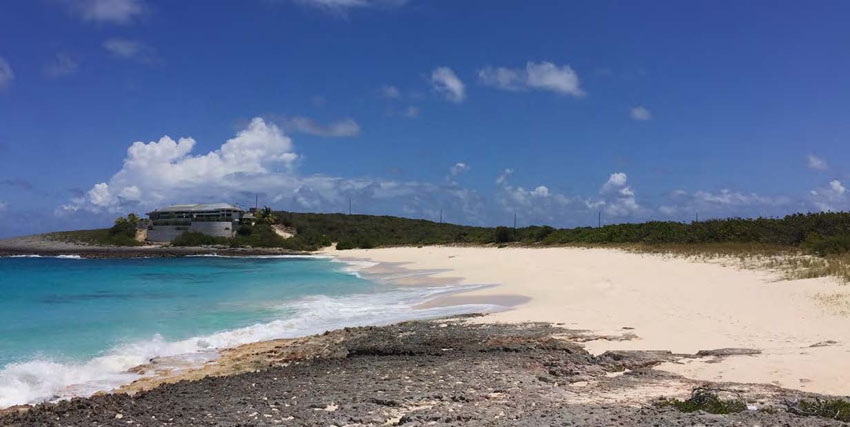 Anguilla is worried about the future of its sea turtles, whose number has considerably declined due to over exploitation of natural resources, as is true elsewhere in the Caribbean. In an attempt to reverse this trend, Anguilla’s Department of Fisheries and Marine Resources set five goals in May 2016 to try and achieve by April 2019:
Anguilla is worried about the future of its sea turtles, whose number has considerably declined due to over exploitation of natural resources, as is true elsewhere in the Caribbean. In an attempt to reverse this trend, Anguilla’s Department of Fisheries and Marine Resources set five goals in May 2016 to try and achieve by April 2019:
- Identify and evaluate the sea turtle population as well as the sites they frequent;
- Identify threats to sea turtles and create strategies to combat them;
- Define and put into place a framework and activities to help protect sea turtles and the evolution of their population;
- Provide technical expertise on a local level for the protection of sea turtles and increase the amount of knowledge on the subject;
- Create better public awareness campaigns, locally and off-island, emphasizing the importance of protecting sea turtles and the coastline;
Among other initiatives is the training of 20 or so guides —including some fishermen— to lead eco-tours about the subject of sea turtles. With a total budget of 440,000 Euros, this project received 400,000 Euros from BEST.
Second project : Protect the Lesser Antillean Iguana
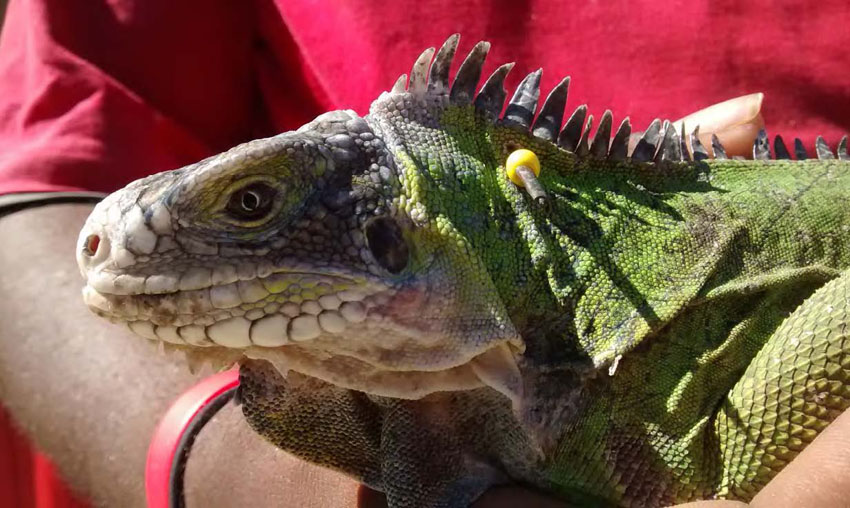
The Lesser Antillean Iguana — Iguana delicatissima — is in danger of extinction, displaced by the common iguana — Iguana iguana — an invasive species with which it reproduces, and as a result after several decades the endemic species is disappearing. Anguilla is lucky in that its Lesser Antillean Iguanas are still present on the island, which is no longer the case in Saint Martin. As a result, Anguilla had to quickly take action to preserve this precious natural heritage. The solution is radical: it is necessary to isolate the reptiles on an island far enough away from other islands to make it inaccessible to the common iguana, which is a good swimmer. The capturing of the Iguana delicatissima has begun, but genetic testing must be done to make sure they are not hybrids. Only such a genetic test can provide 100% certification, as morphologic characteristics can be misleading. These reptiles are then placed in an enclosure while awaiting the results of the test, and if they pass, they are relocated to Prickly Pear, where no common iguanas have been sighted. A study is underway to examine the transfer of these iguanas, as well as the evolution of their population on their new island, their reproductive habits, their nutritional regime, and their overall wellbeing. The conclusion so far is that by all indications the Iguana delicatissima will prosper on Prickly Pear. The common iguana also poses a threat to the Lesser Antillean Iguana on the islands of Saint Barthélemy and Sint Eustatius, which have created a partnership through the Territorial Environmental Agency in Saint Barth and the Statia National Parks Foundation.
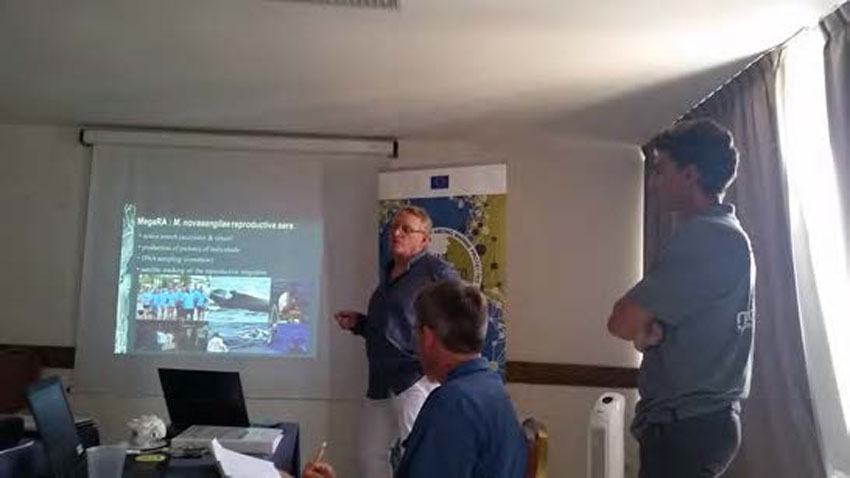 Last April we talked about a project to create a network of protected marine zones in all countries that border the northern and southern sectors of the Atlantic Ocean. Led by the European Commission, the idea came to fruition after Romain Renoux, coordinator for the European BEST project for the Caribbean islands and representative of the Agoa sanctuary for the protection of marine mammals in Saint Martin, went to Brussels to present the actions taken by Agoa and the Réserve Naturelle as part of the Megara mission, on the corridors of migration for humpback whales, who do not recognize international borders as they migrate. Convinced by the project, the European Commission decided to finance the creation of workshops with the protected marine zones that are already dealing with this subject, as well as with countries interested in improving their knowledge about the Atlantic Ocean migration corridors. The first of these workshops was held on May 15-17 in Saint Martin at the Beach Hotel. Saint Martin, Sint Maarten, Saint Barth, Guadeloupe, Martinique, Bermuda, The United States, The Netherlands, and Cape Verde were all able to share their experiences and their know-how. All of the countries and islands linked by the migration corridors used by the humpback whales are well aware how important it is for each of them to do their part in providing efficient protection for these large marine mammals. Representing Saint Martin, Julien Chalifour, director of the Réserve’s scientific department, and Michel Vély, president of the Megaptera association, presented the results of the three Megara missions in 2014, 2015, and 2017, emphasizing the importance of the reproductive zone between Saint Martin, Anguilla, and Saint Barth.
Last April we talked about a project to create a network of protected marine zones in all countries that border the northern and southern sectors of the Atlantic Ocean. Led by the European Commission, the idea came to fruition after Romain Renoux, coordinator for the European BEST project for the Caribbean islands and representative of the Agoa sanctuary for the protection of marine mammals in Saint Martin, went to Brussels to present the actions taken by Agoa and the Réserve Naturelle as part of the Megara mission, on the corridors of migration for humpback whales, who do not recognize international borders as they migrate. Convinced by the project, the European Commission decided to finance the creation of workshops with the protected marine zones that are already dealing with this subject, as well as with countries interested in improving their knowledge about the Atlantic Ocean migration corridors. The first of these workshops was held on May 15-17 in Saint Martin at the Beach Hotel. Saint Martin, Sint Maarten, Saint Barth, Guadeloupe, Martinique, Bermuda, The United States, The Netherlands, and Cape Verde were all able to share their experiences and their know-how. All of the countries and islands linked by the migration corridors used by the humpback whales are well aware how important it is for each of them to do their part in providing efficient protection for these large marine mammals. Representing Saint Martin, Julien Chalifour, director of the Réserve’s scientific department, and Michel Vély, president of the Megaptera association, presented the results of the three Megara missions in 2014, 2015, and 2017, emphasizing the importance of the reproductive zone between Saint Martin, Anguilla, and Saint Barth.
The European BEST program has launched its third and final call for projects to improve the biodiversity of the Overseas Territories of the Caribbean, and has pre-selected eight dossiers. As creating such a dossier can be complicated, a workshop was held in Saint Martin on June 15-16 at the Beach Hotel in Marigot to help candidates with the process before submitting their final versions. Anguilla participated, as well as Bonaire, Bermuda, the Cayman Islands, Curacao, Saint Barthélemy, Sint Maarten, and the Turks & Caicos. A committee of experts will evaluate the proposed projects, and the European Commission will select the best.
The most recent management council meeting for the Agoa sanctuary for the protection of marine mammals took place on January 11, 2017 in Martinique, in two parts.
Saint Martin was represented by Ramona Connor, vice president of the Collectivité ; Nicolas Maslach, director of the Réserve Naturelle ; Bulent Gulay, president of Métimer ; Laurence Vallette for Marine Time ; and Romain Renoux on behalf of Agoa in Saint Martin. First, the council concentrated on several achievements from 2016, notably whale watching and the good practices that should accompany this activity. Most of the whale watching companies benefitted from training in October 2016 to help reinforce these practices. In addition, Agoa worked with the organizers of large nautical events — Heineken Regatta in Saint Martin, The Bucket in Saint Barth, Karujet in Guadeloupe, Jet Race in Martinique — on the one hand to make sure the participants know exactly what to do in the case of encountering a marine mammal, and on the other hand, to verify if marine mammals are present in the area to reduce the risks of a collision. A report on the partnership with the association, «My School, My Whale”, highlighted not only the use of pedagogical tools and visits to 14 classes on the four French Caribbean islands, but also an excursion by boat in late June 2016 for a seventh grade class at the French Quarter middle school.
Le renforcement de l’intégration régionale Reinforcement On A Regional Level 20 Le Journal de la Réserve Naturelle Nationale de Saint-Martin n°28 avril 2017 In the second part, council members discussed projects for 2017, with the principal focus on the REMMOA program for the «census of marine mammals and other pelagic fauna by aerial observation”. This national program was launched in 2008 in the French West Indies by the Agency for Protected Marine Areas and its goal is to increase our knowledge about such species as marine mammals and birds, rays, sharks and sea turtles, in order to reinforce their protection. The different marine zones covered by REMMOA in 2017 — Martinique, Dominique, Guadeloupe, Saint Barth, Saint Martin, Sint Maarten, Saba, Saint Eustache — will be the subject of new aerial coverage. The comparison between the results of the different phases should allow for an estimation of the evolution in the populations of various species, and provide useful information on the quality of the overall marine environment. The program also provides a look at the distribution at sea for certain human activities — maritime traffic, pollution, fishing — that can be potential threats to the pelagic fauna in that same zone. A second project, titled CARI’MAM, hopes to reinforce the international cooperation between several Caribbean countries, including the French islands, in order to improve our knowledge about marine mammals and the management of sanctuaries. Finally, the council proposed a new regulation by the prefect on the observation of marine mammals that concerns all of those who are involved in nautical activities, including individual boat owners, as the current regulation concerns only professionals in the whale watching business. With such a regulation, the rules about approaching and observation that are only recommendations today would become obligatory tomorrow.
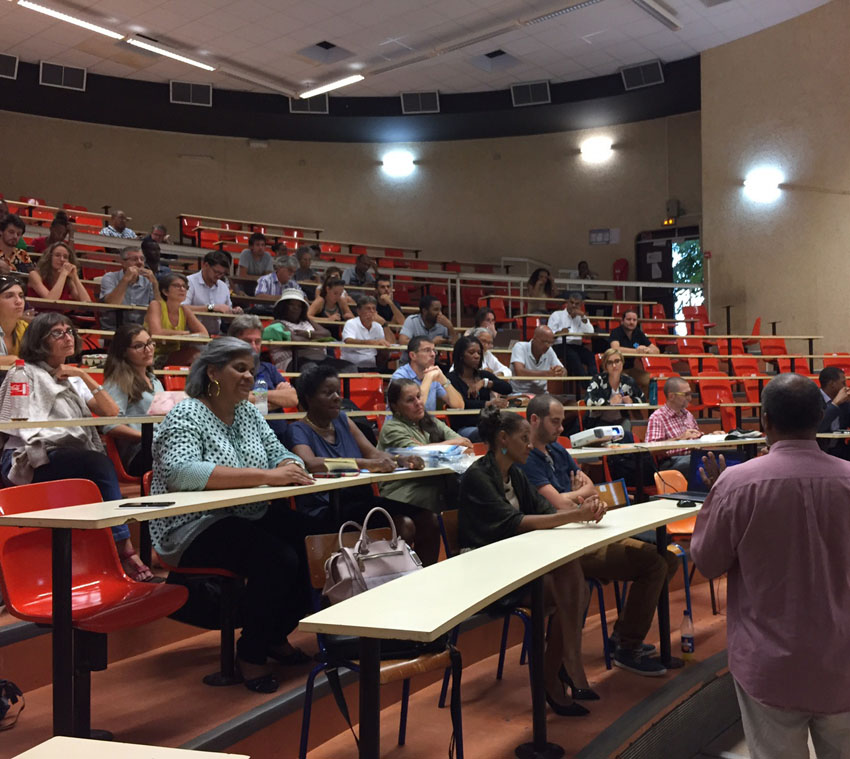 As in November 2015 in Saint Martin, a «Kozé Agoa» was organized in Martinique on January 10, the evening before the council meeting. The public was invited to the law school auditorium on the university campus for a presentation on the marine mammals of the Caribbean, the Agoa sanctuary, the CARI’MAM project (read above article), and the initiatives led by associations in Martinique. The audience was also instructed in the good practices for observation of cetaceans.
As in November 2015 in Saint Martin, a «Kozé Agoa» was organized in Martinique on January 10, the evening before the council meeting. The public was invited to the law school auditorium on the university campus for a presentation on the marine mammals of the Caribbean, the Agoa sanctuary, the CARI’MAM project (read above article), and the initiatives led by associations in Martinique. The audience was also instructed in the good practices for observation of cetaceans.On December 12, 2016, Romain Renoux participated in a meeting organized by the Collectivité to examine the procedure for Saint Martin to join the Organization of Eastern Caribbean States (OECS).
Aline Hanson presided alongside the ambassador of the OECS, and several subjects of common interest between the Collectivité and this organization were evoked. Romain Renoux, coordinator of the European BEST Project for the Caribbean islands, represented the Réserve Naturelle and presented the two BEST programs currently underway. The first comprises financing for biodiversity conservation projects, and the second the identification and spatial distribution of these zones in terms of biodiversity. Both projects apply to the European islands in the Caribbean.
Did you know that the United States and France collaborate on marine environmental issues and the management of protected marine areas (AMP)?
On January 18 & 19, 2017, the National Oceanic and Atmospheric Administration (NOAA) and the French Embassy in the United States organized «French-American Climate Talks on Oceans» - FACTO - in Virginia. The French Agency for Biodiversity was among those invited, as well as Sandrine Pivard, the new director of the SPAW-RAC. Romain Renoux, who represents the Agoa sanctuary in Saint Martin, attended via video conference and spoke about the Réserve Naturelle of Saint- Martin, the Agoa sanctuary, and the creation of an international network for those sanctuaries that protect the Caribbean marine mammals : Agoa for France, Yarari for The Netherlands, La Samana in the Dominican Republic, and Stellwagen Bank National Marine Sanctuary, run by the NOAA, in Massachusetts Bay. He also insisted on the necessity of trans-frontier cooperation between nations in order to respond to the challenges of ecological connectivity. This cooperation is advancing, notably through the CARI’MAM project (read above article) and a program that pairs the sanctuaries.
Caroline Fleury and Ashley Daniel represented the Réserve Naturelle de Saint-Martin at the French West Indies ornithological conference on November 9 & 10, 2016 at the National Park Center in Saint Claude, Guadeloupe.
They presented the results of scientific studies on coastal waders and marine birds, such as the white-tailed tropikbird, the least tern, and the brown noddy. They also detailed the threats to local birdlife: silt in the salt ponds, runoff of gray water, pollution... and noted the results obtained since these studies began, respectively in 2011 and 2009. Several ornithological associations also participated in this conference, including, among others, the DEAL and the ONCFS, as well as the American association «Birds Caribbean,» whose goal is to encourage children to put aside their tablets and smart phones, and pay more attention to nature.
The BEST initiative has moved into high gear. As the phase for the identification of ecosystem profiles on all of the European islands in the Caribbean has been completed, the final document has been approved by the European Commission, and is now available for the public to consult on the Commission’s website.
Currently, BEST is entering into the operational phases for financing of field projects for the preservation of the region’s biodiversity. Four such projects have already been validated after the first call for projects launched in September 2015 throughout the Overseas Territories in the Caribbean, and will benefit from funding as high as 400,000 €. The projects comprise: saving the marine turtles in Anguilla; creating coral nurseries in Sint Maarten, Saint Eustache, Saba, and the Turks and Caicos; to create a marine park in Aruba; and to fight against invasive species in the British islands of the Caribbean. A new call for projects was launched in April 2016, once again directed at the Overseas Territories (PTOM), for maximum funding of 100,000 €. Twenty eligible projects were presented, 18 of which were preselected. As the dossiers can be complicated to complete, a capacity building workshop offering help was held in Saint Martin on July 21 and 22 at the Beach Hotel in Marigot, in order to train and support the candidates, whose projects were due by August 29. Bermuda, The Cayman Islands, Saint Eustache, Anguilla, Montserrat, Bonaire, Saint Barth, Saba, and Sint Maarten all participated. On September 19 and 20, a committee of four experts comprising Cyril Barnerias from the Global Environment Facility; Eric Newton, a biologist based in Curacao; Paul Hoetjes, coordinator for the nature policies for the Dutch islands; and Yves Renard, a biodiversity expert based in Sainte Lucia, met in Saint Martin to evaluate the propositions. Each project was presented to the European Commission, which retains the 12 best, for a total of 1 million € in funding. Among these projects are such topics as reforestation, protection of the Petites Antilles iguana, the fight against lionfish, and the restoration of coral reefs. All will be undertaken in 2017, and the final call for projects will be launched in 2017, once again for PTOM’s. The European BEST initiative is coordinated in the Caribbean by the Spaw-Rac and the Réserve Naturelle de Saint-Martin. Les

Laurent Juhel has designed an explanatory and highly aesthetic poster, intended to clearly inform the managers of biodiversity throughout European Caribbean.
The poster presents the BEST initiative, details about funding opportunities, how the committee of experts functions, and the first four validated projects. This poster was approved at the annual meeting of the GCFI in November 2016 in the Cayman Islands, in order to make sure all those concerned in the Caribbean are aware of this initiative.
The managers of Protected Marine Areas (AMP) from throughout mainland and overseas France have the opportunity to meet once a year at their annual Forum.
This year, thanks to support from the Agency for Protected Marine Areas, ATEN, and the Overseas Ministry, Saint Martin has the chance to host them! On October 25-27, 2016, at the Beach Hotel, 50 such managers were able to exchange ideas about their daily work, and share their experiences, based on common themes. One atelier explored the practical question about management of moorings, as well as the subject of ecological connectivity, which consists of working in a network in order to take into account the ecological reality of migratory species, such as certain birds or humpback whales. The implication of the general community, in terms of awareness and taking of responsibility by citizens, as is necessary in the management of protected areas was also evoked. Romain Renoux, head of regional cooperation and education for the Réserve Naturelle de Saint Martin, was the president of the Forum since 2014 and has passed the baton to Karine Pothin, director of the Réserve Marine de La Réunion, for the next two years. Overseas territories were in the spotlight and Julien Chalifour, head of the scientific department, presented recent projects by the Réserve, including the creation of coral nurseries, as well as studies on birds and sea turtles. Later, the participants were able to enjoy field trips and see the improvements made at several sites, from Rocher Créole to Pinel, by way of Tintamare, aboard two catamarans - Scoobitoo and Solana, both partners of the Réserve Naturelle, which financed this excursion at sea
After two years of working in collaboration with the 15 European islands in the Caribbean, the first portion of the BEST project is completed.
Amandine Vaslet, who coordinates the BEST program for the Caribbean along with Romain Renoux, submitted a full scientific and technical dossier to the European Union. This report includes profiles for all the ecosystems for these small slices of Europe scattered in the Caribbean Sea, as well as a list of geo-reference for the 92 key zones for regional biodiversity, as well as the 43 environmental corridors of international importance. This document has achieved its goal, which is to help Europe make the best choices concerning future investments for the protection of the Caribbean biodiversity. Amandine was highly congratulated for the quality of her work in a particularly complex region: 50% of the Overseas European Territories are located in the Caribbean Sea and are governed by France, The Netherlands, or Great Britain. This project, financed by the European Commission, was jointly run by the CAR-SPAW based in Guadeloupe, and the Réserve Naturelle de Saint-Martin.
Final projects were due by August 29.
https://portals.iucn.org/best/
http://ec.europa.eu/environment/nature/biodiversity/best/index_fr.htm.
BEST NEWSLETTER IS ON LINE. FOLLOW THE LINK :
http://ec.europa.eu/environment/nature/biodiversity/best/pdf/best_newsle...
The managers of the Protected Marine Areas (AMP) of the French Caribbean Islands met on June 16 & 17 in Saint Barthélemy for their annual roundtable. The Réserve Naturelle de Saint-Martin was among the participants, along with the Territorial Environmental Agency of Saint Barth, the national marine park of Guadeloupe, and the mission to create a national marine park in Martinique. After a tour around the table during which each of the protected areas presented their ongoing activities and shared information on their national strategies, the managers worked together in ateliers on specific themes:
- Sargassum seaweed
- Health of the coral reefs
- Management and control of human activities in the protected areas
- Environmental restoration of damaged marine sites, especially with the creation of coral nurseries
- Fishing regulations
- Creation of a European Interreg project to protect marine mammals in the Agoa Sanctuary and beyond.
Inspired by the concept of Atlanticism, the European Commission has come up with the idea of a network of protected marine areas in all of the countries that border the Atlantic Ocean, both north and south.
Romain Renoux, coordinator of the European BEST Project for the Caribbean islands, and representative for the Agoa sanctuary for the protection of marine mammals in Saint Martin, was invited in mid-November 2016 to the first workshop concerning this project, as the European Commission hopes to get some pilot activities up and running to kick off this partnership between the various nations. He presented activities organized by Agoa, as well as those of the Réserve Naturelle in the framework of the Megara mission concerning the corridors of migration for humpback whales, as they are oblivious to frontiers. Convinced, the European Commission decided to finance a series of strategy meetings with the protected marine areas in countries already implicated in this area — France, Holland, The Dominican Republic, and the United States — as well as with those countries hoping to improve their awareness about these corridors of migration, notably Bermuda. The first of these ateliers will take place before summer 2017. The Réserve Naturelle and Agoa share an interest in advancing the protection of the humpback whales, which visit our waters part of the year, as well as educating the European Commission about this subject and eventual financing for future projects.
Caroline Fleury, who does a monthly inventory and scientific study of shore birds around six ponds in Saint Martin for the scientific office of the Réserve,
was able to confirm that the French Antilles shelter a large number of migratory and resident species. She made her report during the national meeting for contributors to the observatory of coastal waders, or those birds that live in the humid zones along the shore. The meeting took place on November 17-18, 2015 in the heart of the Camargue, at the Domaine de la Tour du Valat, a research centre for the conservation of humid zones in the Mediterranean. For Fleury, this meeting was the occasion to meet her national counterparts from the association of Réserves Naturelles de France, and also improve her competence in terms of the study of birds. Of course, the season for the observation of migratory birds is not the same in Saint Martin as in the Camargue, and a number of the birds observed in the warmer months in Europe move to the tropics when it starts to get cold.
A videoconference between Martinique, Guadeloupe, and Saint Martin united members of the Agoa whale watching commission on February 18, 2016.
The goal was to propose a good practices guide to better manage this commercial activity, which is currently regulated by a charter on a volunteer basis. The objective is to change this charter into a prefectural decree, but keeping the spirit of the original text and in cooperation with the operators, as the idea is not to prohibit this eco-tourism activity, but to reinforce the protection of marine mammals.
The goal of the “Kozé Agoa” organized on November 5, 2015 at the Sandy Ground Cultural Centre Sandy Ground was to inform the population about the marine mammal sanctuary in the French Caribbean.
About 200 people attended the lecture presented by Sophie Bedel, who notes that at least 25 of the 31 marine mammal species in the Caribbean visit the sanctuary, including certain little known species such as Gervais’ beaked whale. Daniel Langlois, director of the Saguenay-St Lawrence Marine Park in Canada, and member of the management council, presented a short film about humpback whales that feed in Canadian waters during the summer, in order to gather strength before swimming back to spend the winter in the waters of the Caribbean, where they reproduce and have their young. Jean-Pierre Concaud, a whale-watching operator in Guadeloupe, spoke about this activity that has been expanding, with at least 20 companies involved in the observation of marine mammals in Martinique, and another 10 in Guadeloupe, with an obligation to respect the strict regulations as decreed by the prefecture. The director of the tourism office, Kate Richardson, evoked the necessity to follow a policy of sustainable tourism, especially in the development of eco-tourism, so why not whale-watching? The Saint Martin branch of the association, My School, My Whale, presented a short pedagogical film made by an elementary school class in Grand-Case.
Paul Hoetjes, coordinator of the nature policy for the Dutch minister of economic affairs, presented the Yarari sanctuary during the management council meeting on November 6, 2015.
Yarari, same as Agoa, is an Amerindian term that can be translated as “haven of peace,” or “area of wellbeing.” And like Agoa, the goal is to protect marine mammals, but also sharks and rays. Concretely, a detailed set of regulations defines the protection of these marine animals in a wide series of domains, from maritime transport and motorboat competitions to the formal interdiction to catch sharks. Yarari covers the national waters of Saba and Bonaire, two islands that are part of the realm of The Netherlands, and will soon include Saint Eustache as well. Sint Maarten, Curacao, and Aruba have expressed their interest in the project but have to hold a vote by their politicians. The idea is to multiply the protected marine zones throughout the Caribbean, where marine mammals are still hunted on occasion on such islands as Saint Vincent, Bequia, and The Grenadines.
The Agency of Protected Marine Zones manages Agoa, which in turn is run by a management council.
After a first meeting held in Martinique on May 21, 2015, this council held its second meeting à Saint Martin, on November 6, 2015. The 53 members of Agoa’s management council followed a very full agenda, of which one of the key points was the results of a major study on commercial activities in the waters of Agoa—activities that represent a potential threat to marine mammals. They examined measures to take in reinforcing the protection of these large animals, and decided, for example, that whale-watching operators will have future training to make sure they follow the best behavior at sea, and better understand the different species and their way of life. More long-term, large boats, such as cruise ships and cargo ships, which represent potential collision danger for large marine mammals, will be taught how to take their protection into account. The council was pleased to welcome the creation of the Yarari sanctuary and officially proposed that the two projected zones be twinned.
Happy to see the protection of marine mammals increase in the Caribbean,
Romain Renoux, representative of the Agoa sanctuary in Saint Martin, and Amandine Eynaudi, director for Agoa for the Agency Of Protected Marine Zones, are working on a protocol for exchanges between Agoa, Yarari, and the Dominican sanctuary La Samana. Five axes of cooperation have been unveiled:
- Scientific cooperation through the exchange of technical information and scientific protocol, to eventually standardize practices in the three sanctuaries, with identical methods of data acquisition;
- Standardization of management for these protected marine zones, with the creation of a management plan, the definition of indicators, and the adoption of a common whale watching guide;
- Transparence in the governance between sanctuaries, notably through the invitation of all to important meetings;
- Shared tools for environmental awareness: flyers, posters, videos...
- And finally the promotion of this Caribbean initiative on a global scale to reinforce the link between the sanctuaries and for the protection of marine mammals.
Since large cetaceans do not know they are in danger of being hit by a sailboat during a regatta,
The Agoa protection sanctuary worked with the organizers of the Heineken Regatta and to teach participating sailors how to avoid collisions. This information was shared on several levels, starting with a briefing with the organizers on the subject of such risks, both for the marine mammals and the men, as well as the proper behavior in the case of a meeting with one of these large animals. The race committee received this information with great interest and as a result a flyer recapping the recommendations was included in the race book given to every participant. At the same time, the same information was reprinted in the prefectural regulations for maritime traffic in French waters during the regatta, which took place the first weekend in March as it does every year. The regatta organization also invited Romain Renoux aboard a committee boat in case there was an eventual encounter with a whale. «2016 was the year for an excellent partnership with the Heineken Regatta, the Réserve Naturelle, and Agoa», concludes Romain, who hopes to put the same kind of program in place with the organizers of the Saint Barth Bucket and Les Voiles de Saint-Barth.
The European project, BEST, is moving forward rapidly. In the field, Romain Renoux, director of the regional cooperation and education office for the Réserve Naturelle, and Amandine Vaslet, responsible for the SPAWRAC mission that is coordinating the project with the Réserve, have resumed the consultation of local contacts on various islands.
The goal of these meetings was to identify the issues facing local biodiversity, in order to best protect it, based on existing scientific studies done in the 15 European territories of the Caribbean: French (Guadeloupe, Martinique, Saint Barth, Saint Martin), Dutch (Aruba, Bonaire, Curaçao, Saba, Sint Eustatius, Sint Maarten), and British (Anguilla, British Virgin Islands, Cayman Islands, Montserrat, Turks & Caicos).
- In the Turks & Caicos, like for the other 14 European islands in the Caribbean, the goal was to identify the key zones for biodiversity and validate the profiles of their eco-systems with local authorities, in the presence of the Department of Environment and Maritime Affairs, the Turks & Caicos National Trust, the Turks & Caicos Reef Fund, The British University of Greenwich, the British Marine Conservation Society, and an environmental consultant.
- In Montserrat, where volcanic eruptions seriously modified the eco-systems on the southern two-thirds of the island, the BEST project was warmly welcomed on November 24-27, 2015 by the minister of the environment, the minister of agriculture, the Montserrat National Trust, the Royal Society for the Protection of Birds, the Coral Cay Conservation, Blue Halo Initiative of the Waitt Institute, the GIS center, the fishermen’s association, two diving clubs, a tourism operator, and a hydroponic agriculture company.
- In the Cayman Islands on February 25, 2016, the Environmental Department - eleven participants representing the governments, the environmental associations, and the Cayman National Trust - validated with Amandine Vaslet the conservation zones for biodiversity, the lists of protected species, and the priorities for environmental protection..
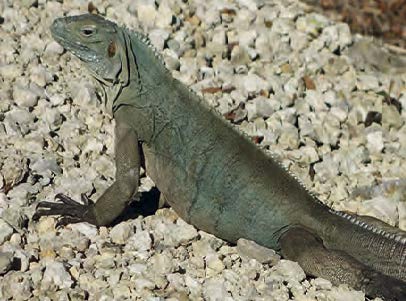
Represented in Brest Nicolas Maslach, Romain Renoux, and Julien Chalifour represented the Réserve naturelle de Saint-Martin at the 3rd national symposium for marine protected areas (MPA),
which took place in Brest on October 6-8, 2015. Under the aegis of the Minister of Ecology, this symposium is organized once every three years by the agency for protected marine zones and the world union for nature conservation. Over 500 professionals concerned by the protection and uses of the marine milieu participated in this event: managers, socio-professionals, scientists, politicians, representatives of government services, associations from all across France and its ultramarine territories. In addition to technical exchanges, this symposium allowed for an updated report, at the halfway point, on the national strategy for the creation and management of protected marine zones (2010-2020) and to reinforce the efficiency of the management of the MPA network in order to allow France to keep its national and international promises in terms of the quality and quantity of the marine protected areas. Organized by more then 50 partner organizations, the 24 ateliers discussed the operational management of the marine protected areas in terms of financing, practices, and et de governance.
The project managers for the ecosystem profiles of the seven regional hubs for the European BEST project met at the European Commission in Brussels.
The project leaders for the Caribbean, the Amazon, and Macaronesia (Azores, Madeira, Canaries, Cape Verde), the polar and sub-polar zones of the Southern Atlantic, the Indian Ocean, and the Pacific Ocean thus had the opportunity to meet and work on the methodologies employed to define the profiles of their respective eco-systems and the key zones for the biodiversiry of their region, in collaboration with CEPF (Critical Ecosystem Partnership Fund). The day of October 19 was dedicated to a public presentation of the results in each region. At this time, Amandine Vaslet presented the results of the exchanges she led with Romain Renoux involving the environmental leaders on the 15 European islands of the Caribbean
On November 7-15, 2015, the island of Hispaniola was the meeting place for the protection of biodiversity «hotspots,»
thanks to the Critical Ecosystem Partnership Fund (CEPF) and its guests, including Romain Renoux on behalf of the European BEST. The first meetings took place on November 7-11 on the eastern side of the island in Haiti, then on November 11-15 in the Dominican Republic. The mission of the CEPF is very close to that of the BEST project, which in a certain way completes it, as the CEPF is interested in the poorest territories in the world and supporting them in the preservation of their eco-systems. Like BEST, with its financing in place, the CEPF creates an eco-system profile in order to identify the priorities in terms of conservation of the biodiversity. The idea, for Romain Renoux, was to learn from the experience of the CEPF in the Caribbean region, particularly by participating in the atelier on the evaluation of their investment in the Caribbean since 2010. Participants included the beneficiaries of funding, financiers, and governmental representatives..
Under the banner of the BEST project, the coordination of which he manages for the European islands of the Caribbean with Amandine Vaslet, Romain Renoux
was invited to a DCNA (Dutch Caribbean Nature Alliance) board meeting, on October 27 and 28,2015, in Curaçao. This was also the ideal occasion to meet the environmental directors of the six Dutch territories of the Caribbean all at the same time, and to discuss the various profiles of the eco-systems created for each area. The presence of the governor of Sint Maarten, Eugene Holiday, allowed for the presentation of the challenges facing the biodiversity on the two sides of the island
Fourteen projects in favor of environmental protection were presented by the PTOMs of the Caribbean as part of the BEST 2.0 program, which provides a maximum level of 400,000 € of funding for each project selected.
Five experts - Cyril Barnerias (DEAL Martinique), Paul Hoetjes (Dutch Overseas, based in Bonaire), Eric Newton (Dutch Overseas, based in Curacao), Tara Pelembe (British Overseas), Yves Renard (Caribbean expert, based in Sainte Lucie) - were asked to examine each project, based on the ecosystem profiles defined by Amandine Vaslet. Since the opening of the call for projects, the team from the Caribbean hub of BEST 2.0, composed of Julie Belmont, head of the mission BEST 2.0 for SPAWRAC, and Romain Renoux, responded to all of the preliminary questions from candidates and helped them complete their projects, before organizing a regional steering committee, with the five experts. They met from December 15-17, 2015, to examine each dossier on a technical and scientific basis. The proposed projects were rated according to precise criteria of evaluation, established by the BEST 2.0 Consortium and validated by the European Commission. They were able to classify the projects, and the results were sent to the BEST 2.0 secretariat then to the European Commission, which eventually selected four projects for a total budget of 1.5 million €. As explained by Romain Renoux during a presentation in Brussels on February 16, these four projects share a dimension close to the realities of their island and a desire to reinforce local capacities. BEST 2.0 will soon launch a new call for projects, open to all of the PTOMs, for smaller subventions, with a maximum of 100,000 €. Additional information is on the website for this program: portals.iucn.
And the four winning projects are....
The Royal Society for the Protection of Birds (RSPB), in partnership with the authorities of Anguilla, The British Virgin Islands, The Cayman Islands, Montserrat, and the Turks & Caicos. This project calls for the reinforcement of the fight against and control of invasive species: fauna (rats, feral cats, goats) and also flora. These invasive species are one of the causes of the diminution of biodiversity, which is particularly true on islands;
- The government of Aruba,for the creation of the first marine park on the island, in partnership with a Dutch scientific organization;
- Imares (Institute for Marine Resources & Ecosystem Studies), the Dutch equivalent of our Ifremer, proposed a project for coral restoration with coral nurseries in Saba, Saint Eustache, Sint Maarten, and the Turks & Caicos, in collaboration with the marine parks on these islands.
- The Department of Fisheries and Marine Resources of Anguillahave a project for the preservation of sea turtles, in partnership with local NGOs, a British university, and the WIDECAST network.
The steering committee for the BEST 3 project
Met on February 10 in Brussels, at which time Romain Renoux, BEST co-coordinator for the entire Caribbean with Amandine Vaslet, presented news in terms of identification of key zones for biodiversity in the 15 European territories in the region. Twenty ateliers regrouping 130 organizations were held that day, with more than 200 experts consulted about the environment and biodiversity. Sixty key zones have been identified and a final synthesis will be published in June 2016 with profiles of the primary ecosystems of the Caribbean.
The Mazda group has made a donation of $3,200 to the Réserve Naturelle de Saint-Martin
In support of its program to protect sea turtles. Maria Zildar Richards, director of the Mazda group for Florida, presented the check to Romain Renoux, on Thursday, February 25, 2016 in Palm Beach... very close to a site where these turtles lay their eggs.
On October 22, 2014, French environmental minister Ségolène Royal, and overseas minister George Pau-Langevin, during their official visit to Guadeloupe, presided over the installation of a management council for the Agoa sanctuary for the protection of marine mammals in the French Antilles. On May 21, 2015, this board held its first meeting at the prefecture in Fort-de-France, Martinique. Its 53 members elected Yvon Combes to the post of president, for a term of three years. Currently first vice president for the association of mayors in Guadeloupe, Yvon Combes has spent his entire professional career working for the National Forestry Office and was instrumental in establishing the National Park in Guadeloupe. Ramona Connor, second vice president for the Collectivity of Saint Martin, is one of the three vice presidents for the council. In order to facilitate the functioning of the Agoa, the management council established a board of 16 members, on which Saint Martin is well represented by: Bulent Gulay, president of the Métimer association; Stéphane Mazurier, vice president of Métimer; Kate Richardson, director of the Tourist Office; and Nicolas Maslach, director of the Réserve Naturelle. The council offered its first unanimous opinion against the use of seismic oceanographic prospection techniques, considering the level of impact involved could result in major impact for marine mammals. An international cooperation committee was also created, in order to work on the best strategies for the protection of marine mammals in the Caribbean region, and beyond. The members of the board next met in Saint Barthélemy on September 29, and the council met in Saint Martin on November 6, 2015 (details in the next edition).
The REMMOA program - whose initials represent the French for «census of marine mammals and other pelagic species by aerial observation»- was launched in the Antilles in 2008, by the Agency for Protected Marine Areas. It continued in 2016 for a six-weeks, between August and October. The goal of this national program is to improve knowledge about certain species, such as marine mammals and birds, rays, sharks, and marine turtles, in order to reinforce their protection. Following the end of the first phase of the project, in which data was collected, the second phase will take place in the various marine zones covered by REMMOA - Martinique, Dominique, Guadeloupe, Saint Barth, Saint Martin, Sint Maarten, Saba, Statia - and comprises a second aerial reconnaissance. The comparison between the results of these two phases will allow for an estimation of the evolution of the populations of these different species and provide useful information on the quality of the marine milieu. This second phase began in the French Antilles, whose exclusive economic zone covers 143,256 square kilometers. The program also provides an idea of the distribution of human activities at sea - maritime traffic, pollution, fishing, etc - that might represent potential threats toward the pelagic species in the same zone. This campaign marks the first concrete technical and scientific exchanges with the Yarari Mammal And Shark Sanctuary (see inset) recently created by The Netherlands for the Dutch Caribbean, as well as with Dominica.
Following the French example, The Netherlands have just created Yarari, a sanctuary for marine mammals — and sharks — in the territorial waters of Saba and Bonaire. Like Agoa, Yarari is an Amerindian word that can be translated as “haven of peace” or a “place of well-being.” In reality, a detailed set of regulations defines the protection of these marine animals as related to diverse domains, such as maritime transport, motorboat races, and the outlawing of shark fishing. The Agoa sanctuary was extremely happy about the news, as the creation of this new sanctuary increases the already existing network of protected marine areas dedicated to the protection of marine mammals. They look forward to joint projects and collaboration with the new sanctuary.
As part of a videoconference, Yvon Combes, president of the management council for Agoa in Guadeloupe; Amandine Eynaudi, representative of the Agoa sanctuary for the Agency of Protected Marine Areas in Guadeloupe, and Stéphane Jérémie, president of the association, Sepanmar, in Martinique, were able to exchange ideas with Ramona Connor, vice president of the Agoa management council, Romain Renoux, correspondent for Agoa in Saint Martin, and Stéphane Mazurier, member of the board and a boat rental company owner, who were together at the prefecture of Saint Martin on September 25, 2015. The goal was to go over the cooperative activities led by Agoa in the past, as well as clarify the protected area’s institutional status, between the Cartagena convention signed by the majority of Caribbean states in 1983 for the protection of marine sites in the region, and the CAR-SPAW, a partner with Agoa, whose mission if to protect the marine biodiversity in the greater Caribbean basin.
The government of Gibraltar invited the overseas British territories from around the world to meet on July 9-15, 2015 for the United Kingdom Overseas Territories Conservation Forum (UKOTCF).This event, which was last held in 2009 in the Cayman Islands, saw the participation of managers of protected British areas in the Pacific, the Indian Ocean, the North and South Atlantic, and the Caribbean basin. These territories have access to the European project BEST, through which the European Commission diffuses indispensable information for selecting and financing the “best” projects for the conservation of ultramarine biodiversity. Romain Renoux, responsible for project BEST for the 15 European territories of the Caribbean, as part of the European cooperation division of the Réserve Naturelle, presented a progress on his work for the identification of key biodiversity, as did his counterpart Maria Taylor, who is based in the Falkland Islands, for her southern Atlantic region. A major interest for this forum is to share common experiences - at the end of the day it is evident that the methodologies remain the same, even at distances of thousands of miles and in wildly differing environments.
Romain Renoux, also in charge of managing the Agoa sanctuary Saint Martin, and Amandine Eynaudi, representative of the Agoa sanctuary for the Agency of Protected Marine Areas, took advantage of this occasion to make a presentation about Agoa, as well as the cooperation that will be put into place with the Netherlands Antilles islands. Next was suggesting to the British islands in the Caribbean (Anguilla, British Virgin Island, Cayman Islands, Montserrat, Turks & Caicos) to get on board with this adventure, and taking the first step by inviting them to join in the effort. The answer is “yes” and a first official contact with the government of Anguilla will encourage technical and scientific exchanges for the protection of marine mammals. This first step could well lead to increasing the size of the zone already protected, thanks to the results of a communication and awareness campaign led by Agoa since its creation. Bravo !
Romain Renoux participated in Green Week 2015, the largest annual event on European environmental policy, which took place in Brussels on June 3-5, 2015, on the theme of “nature and biodiversity ». Responsible for project BEST for the 15 European territories of the Caribbean, as part of the European cooperation division of the Réserve Naturelle, Romain Renoux made a progress report on the state of his work, as did his counterparts from all across Europe.
The European Commission has launched BEST 2.0 and has reinforced its support for the protection of ultramarine biodiversity by offering new possibilities for financing to Overseas Countries and Territories (PTOM). In the Caribbean, this is good news for Saint Barthélemy, the five British Territories, and the six Dutch territories, as there is now 6 M€ available over a period of five years. Studies are underway for such Outermost Regions (ORs) as Guadeloupe, Martinique, and Saint Martin in the Caribbean to benefit from a similar initiative. Stay tuned… Of course, these RUP’s already have access to European funds, if their politicians consider protection of their environment as a major cornerstone of their political strategy. Let’s hope they make the right choice! Concerning the PTOM’s, a first call for projects has been launched, requesting about 400,000 € in aide. These projects will be evaluated by a committee of experts, then followed- up by Romain Renoux, Amandine Vaslet, and the project BEST team for the European territories of the Caribbean, as part of the regional cooperation division of the Réserve Naturelle of Saint Martin. Their mission will be to best advise the project leaders and to make sure that the financing corresponds to the issues identified during consultations with the local representatives in each territory. They will work in concert with Julie Belmont, a new recruit for BEST, based at CAR-SPAW in Guadeloupe and in charge of tracking the new projects as funded.
The consultations led by Romain Renoux and Amandine Vaslet are continuing throughout the Caribbean. After Saint Barthélemy, Guadeloupe, the six Dutch islands, and Anguilla, the project BEST team worked with local representatives in Martinique, the British Virgin Islands, and Saint Martin. The goal is to meet the largest possible group of those active in the protection of the natural environment, present project BEST to them and gather their reactions and their projects for biodiversity conservation. Even is the issues are different, the methodology remains the same. The goal is to define various priorities, especially taking into consideration endangered and endemic species, and ecosystems. Maps allow for clear visualization of the key zones on land and at sea for biodiversity, reflecting a major ecological role. In Saint Martin, trans-frontier challenges with Sint Maarten should be underlined
In Martinique: The Parc Naturel Régional and the two national nature reserves, DEAL, the Conseil Régional, The Agency for Protected Marine Areas, Martinique Entomologie, and the OcéAnvironnement association. In Tortola (BVI): BVI National Trust, the Minister of Natural Resources and the Environment, the Conservation and Fisheries Department, the Agriculture Department, as well as several local associations and experts. One meeting was held with the governor of the BVI’s, to present project BEST. In Saint Martin: the Collectivity of Saint Martin, the Prefecture, the Réserve Naturelle, the Conservatoire du Littoral, and the associations «Les fruits de mer» and «Mon école, ma baleine.»
As part of his training program, Guillaume Escolar, a 22 year-old intern at the Réserve Naturelle from February through August 2015, is especially interested in learning about the systems put in place on neighboring islands to monitor the state of coral and sea plants. He has already met with Tadzio Bervoets, director of the Sint Maarten Marine Park, and plans to meet with the managers of the protected marine zones in Saint Barthélemy, Anguilla, Saba, and Saint Eustatius. A Master’s degree student at the University of La Rochelle, he is studying the management of ecosystems. His internship, as financed by Ifrecor, will not only allow him to increase his knowledge, but also compile and compare the results of various systems already in place, and allow him to propose a standardization of activities throughout the region. His ultimate goal is to improve the conservation of marine zones and communication between islands. At the end of his internship, the Réserve Naturelle will provide a recap of all the existing systems for the directors of the protected marine zones on the five islands, as part of its regional cooperation mission.
The European initiative, BEST, is moving forward rapidly. In the field, Romain Renoux, director of the regional cooperation and education division of the Réserve Naturelle, accompanied by Amandine Vaslet, employee of the SPAW-RAC, who coordinates the project with the Réserve, continues to consult with local contacts on different islands. The goal of these meetings it to identify the challenges facing biodiversity in terms of optimizing environmental protection, based on existing scientific studies in the 15 European territories of the Caribbean: French (Guadeloupe, Martinique, Saint Barth, Saint Martin), Dutch (Aruba, Bonaire, Curacao, Saba, Saint Eustatius, Sint Maarten) and British (Anguilla, British Virgin Islands, Cayman Islands, Montserrat, Turks et Caicos). Once completed, the BEST initiative will allow the European Commission to have the necessary information to select the best projects for financing, so that every euro invested is done so wisely. In Saint Barthélemy, on January 22, 2015, they
In Saint Barthélemy, on January 22, 2015, they met with the Territorial Environment Agency and the association, Saint Barth Essentiel. I
In Saba, on March 24-26, 2015, the board of directors of the Dutch Caribbean Nature Alliance gave them an extraordinary opportunity to meet with representatives of the six Dutch Caribbean islands, and to validate the first proposals with them. 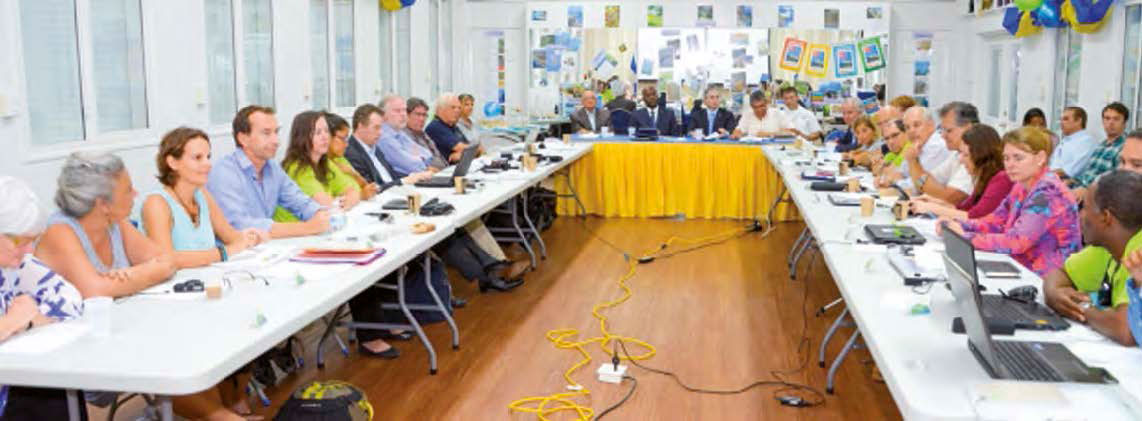
On March 17, in Anguilla, they met with representatives of the Department Of The Environment and its partner, the Anguilla National Trust. Together, they validated propositions of identification for the 11 sites to consider in priority, on land and at sea. Sombrero Island is one such site, for its coral reefs, its aviary species, and the presence of endemic reptiles. The sites of Dog Island and Scrub Island were also included as well as the 25 salt ponds on Anguilla, with comprise an important reservoir for biodiversity, and of which 12 are considered of major importance.
In Guadeloupe on April 23, in the National Park offices, they took part in a roundtable whose other participants included representatives from the Ministry of Ecology, the Conservatoire du littoral, the Agency for Protected Marine Zones, the Regional Council of Guadeloupe, the Botanical Conservatory of Guadeloupe, The National Forestry Office, and SPAW-RAC, as well as several local associations for the protection of nature. Romain Renoux and Amandine Vaslet presented a map of the archipelago of Guadeloupe, exposing the issues concerning biodiversity in the islands. The discussions allowed for the precise definition of the boundaries of these zones, considered priority in terms of biodiversity conservation, by taking into account the source of their most recent data. BEST @ Anguilla BEST en Guadeloupe Le renforcement
The Réserve de Saint-Martin, which since 2014 has led the Project Negara study of lemon sharks, hosted a group of Dutch scientists working with the Marine Park of Sint Maarten, on April 21 and 22, 2015, along with Tadzio Bervoets, the Park director. The two academics were with consultants on assignment by the Dutch government, in order to increase knowledge about the marine zones in the Dutch Antilles, with a special focus on the identification, distribution, and management of sharks and rays. After working in Saint Eustatius and Saba, this team spent two months in Sint Maarten, where they sampled 150 points in the sea and observed numerous Caribbean reef sharks and nurse sharks. Knowing that lemon sharks and tiger sharks had been found in the waters around the French side of the island, the Marine Park contacted the Réserve Naturelle, which lent its expertise to the study by suggesting 18 observation points. The technique used by the Dutch comprised submerging two cameras that recorded in stereo and filmed everything that passed in their field of vision, with bait attached on a telescoping pole to attract these large predators. This means of recording allows for a precise measurement of the size of the sharks, and provides information about the stage of development of the species filmed. Over the course of two days, aboard the boat belonging to the Réserve, three systems of two high-definition cameras were submerged for one hour, pulled out of the water, and then re-submerged at another point, on so on. The Dutch and French each worked on their respective projects : the Dutch concentrating on an inventory and diversity of the various species; and the French continuing their study of the lemon shark, to acquire additional expertise in the manipulation of these individuals. The images recorded will be examined, with the data collected used to enrich global knowledge about sharks. «There are sharks in the waters around Saint Martin that pose absolutely no danger and even signify the good health of our ecosystems. They represent an interesting subject of observation for divers, as the sharks are furtive but not very fierce. But we must not forget that these are wild animals and they should never be fed,” explains Julien Chalifour.
354 Lesser Antillean Green Iguanas were identified on March 22-28 in Martinique, on the small island of Chancel, with the participation of Julien Chalifour, director of the scientific division of the Réserve Naturelle de Saint-Martin, which is a member of a regional network. These observations were made as part of a project coordinated by the Office National de la Chasse et de la Faune Sauvage (ONCFS), as part of a national action in favor of this protected species led by Élisa Curot-Lodéon, director of the «Lesser Antillean Green Iguanas project» initiated by the Ministry of Ecology. Chancel has the advantage of not being invaded by the common iguana, so it represents an ideal site to study the Lesser Antillean Green Iguanas, which are abundant here. This deserted islet was divided into six observation zones, and six teams of two observers each patrolled their zone throughout the day. The mission comprises trapping the iguanas in the trees or on the rocks, weighing and measuring them, checking to see if they had any parasites or wounds, and verifying if they had been banded or had a chip under their skin, which are means of identification that have been used for the past 10 years. If the individual iguana did not yet have a chip, one was implanted subcutaneously. As it is extremely hard to tell one iguana from another, those that had already been identified were marked with a number of their flanks. In the end, 354 Lesser Antillean Green Iguanas on Chancel are now equipped with a chip, including 104 new individuals, as there were 250 that already had chips. This mission provided an occasion for Julien Chalifour to meet the agents working in the projected zones of Saint Eustatius, La Désirade, and Saint Barth - where a bacterial infection caused a high level of mortality in the Lesser Antillean Green Iguanas population - as well as members of environmental protection agencies in Guadeloupe and Martinique. In the near future, as part of this national project, Caroline Fleury will take part in an identical mission on the island of La Désirade.
Comme tous les ans depuis 2013, l’équipe du sanctuaire Agoa pour les mammifères marins dans les Antilles françaises s’est mobilisée à l’occasion de la Karujet 2015, au cours de laquelle plus de 60 jet-skis étaient lancés à pleine vitesse entre Petit-Bourg, Le Gosier, les Saintes, Saint-François et Marie- Galante, dans les eaux de la Guadeloupe. Cette compétition d’engins à moteur représentant une source de dérangement et un risque de collision pour les cétacés, l’Agence des aires marines protégées a préconisé des mesures préventives afin de minimiser les risques, aux frais des organisateurs de la Karujet. Le départ des courses n’a été donné qu’après le survol en autogyre de la zone environnante et l’observation du parcours depuis un bateau, afin de s’assurer qu’aucun mammifère marin ne soit mis en danger. Compte tenu des risques et des perturbations, l’Agence des aires marines protégées a de nouveau cette année demandé que cette étape du championnat du monde de jet-ski se déroule à l’avenir sur une période où les baleines à bosse ne sont pas présentes.
Saint Martin was the host for the first major transatlantic, trans-frontier event on the management of marine mammals! On March 28, 2015, representatives from France, Holland, Sint Maarten, Saba, Saint Eustatius, the AGOA sanctuary, the United States Stellwagen Bank National Marine Sanctuary in Massachusetts Bay, the Dominican Republic’s sanctuary in Samana Bay, and SPAW-RAC worked together on the management theme, at the initiative of the Dutch Minister of Economic Affairs, responsible for the environment. This working session has several goals, of which the first was an exchange on the various actions completed by different sanctuaries around the Atlantic, not only on scientific information but also means of communication. An other important goal is to promote the new joint activities concerning humpback whales: scientific studies, information exchanges, communication campaigns, and a joint effort on acoustic monitoring. The long-term objective is the acquisition and sharing of information throughout the entire Caribbean, with a harmonization of protocols.
The European Union, which comprises 9 Outermost Regions and 25 Overseas Countries and Territories worldwide, has placed the protection of its exceptional biodiversity at the top of its list of priorities, as seen in the creation of the BEST project, coordinated in the Caribbean by the SPAW RAC and the Réserve Naturelle of Saint Martin. The goal is to establish an inventory of the biodiversity and its challenges in terms of conservation in each of these European territories and to guarantee the continuation of European funding, which often is lacking at the moment. Along the same lines, the second International Conference On Biodiversity and Climate Change in Overseas Europe, which was held in Guadeloupe on October 22-25, 2014, attracted 200 attendees who represent the who’s who of leaders, managers, and scientists concerned by these challenges, including Ségolène Royal and George Pau-Langevin, respectively minister of the environment, and overseas minister. Co-organized by France, the Bristish Virgin Islands, the association of overseas countries and territories, the Region of Guadeloupe— which led the conference for the Outermost Regions—the Secretary for the Convention on Biological Diversity, the International Union For Conservation of Nature (IUCN), and the European Commission, this meeting allowed all of these territories—British, Spanish, Portuguese, Danish, and French—to work together in a series of five workshops that allowed them to discuss such subjects as the decline in the biodiversity, research, the economic impact of natural environments, the mobilization of financial resources, and of course the effects of climate change. This work resulted in a roadmap that defines the actions that are required over the next few years to respond efficiently to the challenges of biodiversity and to climate change.
Romain Renoux, the head of regional cooperation for the Réserve and for the coordination of the BEST project in the Caribbean, took the opportunity to meet his counterparts from around the region and to share the most possible information with them
France’s Protected Areas Agency, managers of the Agoa marine mammal sanctuary, took advantage of the visit to Guadeloupe by French minister of the environment Ségolène Royal, and overseas minister George Pau-Langevin, to officially install the management council for Agoa at the offices of the National Park of Guadeloupe on October 22. Composed of 53 members who represent the diversity of Guadeloupe, Martinique, Saint Martin and Saint Barthélemy, this council will define and ensure the management of the sanctuary, establish its activities program, and provide evaluation based on a management chart as approved. Saint Martin is represented by prefect Philippe Chopin, the president of the Collectivité, Aline Hanson, who was represented here by vice president Ramona Connor, Nicolas Maslach, director of the Réserve Naturelle of Saint-Martin, Gary Page (Saint Martin fisherman’s association), Bulent Gulay (federation of nautical industries in Saint Martin), Stéphane Mazurier (operators of marine mammal observation and tourism for the Northern Islands), and Jeanne Rogers-Vanterpool (president of the tourist office). Created on October 23, 2012, the Agoa sanctuary covers over 55,000 square miles, or the totality of the economic zone exclusive to the French West Indies. Its goal is to guarantee a high level of conservation for marine mammals by protecting them, as well as their habitat, and the impacts - direct or indirect, confirmed or potential - of human activities.
Getting an estimate for the actual cost of building a cruise ship dock on a Caribbean island is one of the first steps, for example, in its construction. But what is the cost to the environment? What consequences, generally considered irreversible, would this new dock have for the eco-systems? On the coral? The beaches? This is one of the points that Romain Renoux and 19 other managers from a total of 15 Caribbean territories discussed in a workshop on the economic evaluation of eco-systems. Organized by the International Coral Reef Initiative (ICRI) and the Dutch Ministry of the Economy, September 16- 18 in Bonaire, this workshop was designed to demonstrate the necessity to make all leaders - including elected officials - aware with total transparency that the cost to the environment from construction and concrete is not neutral. And at the end of the day, the bill may be higher than expected!
On November 12-19, 2014, In Sydney, Australia, the International Union For Conservation of Nature (IUCN) held the World Parks Congress. Held once every ten years it attracts the leading players involved in the protection of nature, with 6000 attendees from 70 countries, including Saint Martin, represented by Nicolas Maslach, in his role as a member of the board of the Forum of Protected Marine Areas, which financed his trip. The director of the Réserve spoke publicly on several occasions to present various activities of the Réserve, especially in the field of protected area management, their governing, actions that promote conservation of biodiversity, and the fight against climate change. For Maslach, the congress provided an occasion to meet Australian managers of protected areas and better understand their efforts and their tools for the development of their immense coastline.
It was on the Ile d’Oléron, on October 15-17, 2014, that Romain Renoux and Franck Roncuzzi met with 50 other managers of protected marine areas—national parks, nature reserves, marine parks, Natura 2000 zones, Conservatoire du Littoral sites—during the 13th annual Forum for Protected Marine Areas, an informal network that these managers belong to. For them, it provides an opportunity to share mutual experiences as well as successful techniques, and discuss their difficulties. One issue is funding, the eternal holy grail, but also such questions as the possible eco-certification for anchors and moorings in order to make them more compatible with the management of protected zones, as well as the prospective on climate change. Renoux had the honor of being elected president of this Forum for the next two years, which means that with his office, he will work on the themes for the next national colloquium for protected marine areas in 2015, and will centralize and bring the concerns of the managers to the attention of the minister of the environment and the agency for protected marine areas.
We spoke about project BEST in our last issue, and today it is making great strides. The project was initiated so that the EU could strengthen the sustainable conservation of the unique biodiversity of its 34 overseas territories, particularly its 15 island territories in the Caribbean, whether French, Dutch or British. The idea is to establish an inventory of the biodiversity and its challenges, in terms of conservation, that exist in each of these territories, and to ensure long-term funding, which they often lack today. In cooperation with the IUCN (International Union for Conservation of Nature) and CAR-SPAW (Centre d’activités régional pour les espèces et les espaces spécialement protégés de la Caraïbe), based in Guadeloupe, the Saint-Martin Nature Reserve plays a key role in the project since it is going to coordinate the platform or the “hub”, made up of all these territories. This task was entrusted to Romain Renoux, Head of the Regional Cooperation Department at the Reserve, in collaboration with Amandine Vaslet, an employee at CAR-SPAW, as part of the agreement between the Reserve and this center. Amandine, who completed a PhD at the Université Antilles-Guyane in Guadeloupe on fish ecology in mangroves and in seagrass beds, is being hosted and based at the Reserve for two years, which will run until June 2016. She is now seeking to make contact with local stakeholders on the islands concerned in order to write up a summary analysis about the different ecosystem profiles, and to identify clean-up action priorities for each territory. All work will be done by consulting with the local networks and institutions of each country, and this information will be shared bit by bit as the project advances. Meetings are set up and the final report, written in English, will serve as database for the European Union before launching sustainable actions to preserve its ecological environment in the Caribbean... and before putting any funding forward.
In Saint-Martin, Romain Renoux and Amandine Vaslet gave a presentation of the project to Alex Richards, Head of European Affairs and Regional Cooperation. In Guadeloupe they have already been in contact with the National Park, the Director of the Environment, the Regional Council and the Antilles branch of the Agence des Aires Marines Protégées.
Strategies to manage invasive alien species were the subject of a workshop organized by the Nature Reserve from May 12th to 14th, at the Mercure Hotel. Saba and St. Eustatius Marine Parks attended, along with Petite-Terre Nature Reserve, Bonaire National Park, the Marine and Terrestrial Park of Anguilla, the Minister of Environment from Anguilla, the ONCFS from Guadeloupe, as well as the British Royal Society for the Protection of Birds (RSPB). The first two days were devoted to sharing experiences, with presentations of different actions used to eradicate and control the invasive species found in each territory. Anguilla is the only island to have successfully eradicated all the rats that had invaded Dog Island through implementing a very costly and extensive program of poisoning. They were warmly congratulated by the others as the fight against invasive species is a challenge for everyone. Bonaire, like Saint- Martin (see pages 12 and 13), faces the invasion of the underwater algae Halophilastipulacea. The ONCFS from Guadeloupe, for its part, has had a proliferation of the green iguanas, whilst St. Eustatius is fighting against rats and achatinas that is, of course, when the orchid-loving goats leave them the time to do so!
The third day was spent out in the field at Tintamare where the Reserve gave a demonstration of their method of rodent eradication, which trapped and killed 211 rats and 79 mice in March 2013.
Large marine mammals do not respect borders, and during their long migration across the Caribbean, they travel through protected marine areas where their protection is more or less well assured, or not at all.
Ideally, to improve their protection, we need to ensure the preservation of these large animals between the various territories as they pass through by setting up a harmonized transboundary management scheme.
Thus, the Life Web Project, organized by CAR-SPAW, took place in San Juan from April 23rd to 25th, 2014. It is the United Nations and the government of Puerto Rico’s environmental program, and it brought together experts from numerous regions that are concerned by these large animals. Romain Renoux, who represented Saint-Martin and the Agoa Sanctuary, was elected chairman of the meeting.
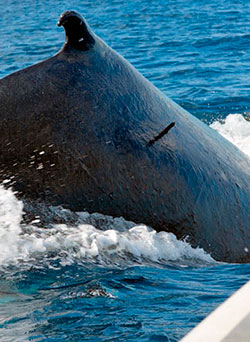 He worked on defining programs for cooperative protection of marine mammals, along with representatives from Trinidad and Tobago, Grenada, Barbados, St. Lucia, Guadeloupe, Antigua and Barbuda, St. Kitts and Nevis, the Netherlands Antilles, the British and American Virgin islands, Puerto Rico, the Dominican Republic, Jamaica and Costa Rica. Boston and Canada were also represented as these large mammals frequent their waters in the summer.
He worked on defining programs for cooperative protection of marine mammals, along with representatives from Trinidad and Tobago, Grenada, Barbados, St. Lucia, Guadeloupe, Antigua and Barbuda, St. Kitts and Nevis, the Netherlands Antilles, the British and American Virgin islands, Puerto Rico, the Dominican Republic, Jamaica and Costa Rica. Boston and Canada were also represented as these large mammals frequent their waters in the summer.
The meeting ended positively, that is to say that the protection of marine mammals is moving in the right direction in the Caribbean, and more and more territories have realized the necessity to preserve them. Specific proposals were made, such as to create sanctuaries or to reduce the impact of human activity (noise, pollution, fishing ...). All that remains today is for the participating nations to turn these proposals into a reality by putting them into action in their territorial waters.
The European Union knows that most of its biodiversity exists in its 34 overseas territories and that it is imperative to preserve them. In the Caribbean, 15 European territories are concerned. They are French (Guadeloupe, Martinique, Saint Barths, Saint-Martin), Dutch (Aruba, Bonaire, Curaçao, Saba, Sint Eustatius, Sint Maarten) and British (Anguilla, British Virgin Islands, Cayman Islands, Montserrat, Turks and Caicos), and are all involved in the BEST program, implemented in 2010 by the European Commission, on an experimental basis to preserve their biodiversity. In Brussels on January 30th and 31st, 2014, after having presented the Saint Martin Nature Reserve to the European Commission, at the first steering committee of the project BEST, Romain Renoux, responsible for the Regional Cooperation Division, was appointed to become the coordinator for the «hub» platform of these 15 territories. This appointment confirms that Saint Martin’s role as a Caribbean «hub» for all environmental issues within the region is a necessary one.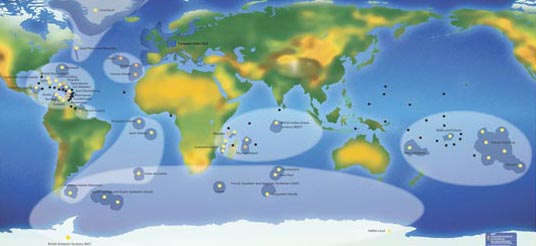 With the cooperation of the IUCN (International Union for Conservation of Nature) and CAR-SPAW based in Guadeloupe, Saint Martin Nature Reserve had previously responded to a proposal from the European Commission to define the scientific criteria most relevant to the preservation of the biodiversity in the overseas territories. A work plan has been drawn up for the next four years.
With the cooperation of the IUCN (International Union for Conservation of Nature) and CAR-SPAW based in Guadeloupe, Saint Martin Nature Reserve had previously responded to a proposal from the European Commission to define the scientific criteria most relevant to the preservation of the biodiversity in the overseas territories. A work plan has been drawn up for the next four years.
Nicolas Maslach, Director of the Reserve and Franck Roncuzzi, Head of the Technical Division and Nature Protection Unit, went to Banyuls (Eastern Pyrenees) at the end of April to attend the annual congress for French Nature Reserves (Réserves naturelles de France – RNF), where they met with over 400 other participants. The project to create a National Biodiversity Agency was presented at the auditorium, and in the near future it will bring together all the establishments working in favor of the environment. Nicolas Maslach and Franck Roncuzzi are both part of the Overseas Commission at the RNF and exchanged workshops with their peers.
From April 10th to 13th, 2014, Guadeloupe welcomed more than 60 jet-skis for Karujet, an annual world championship that took place between Petit-Cul-de-Sac-Marin, Pointe-des-Châteaux and the Saintes. This popular nautical event enjoyed by a large public, can however have a significant impact on marine mammals that are very sensitive to noise and are slower than these motorized engines that risk hitting them. It is particularly dangerous for humpback whales that are in full breeding and calving season at the time of the race. As explained to us by Romain Renoux, in charge of managing the Agoa Sanctuary in Saint Martin, one of the roles of the sanctuary is to define recommendations to avoid disturbing or harassing marine mammals. In order to reduce the risks at hand and avoid accidents, the prefect of Guadeloupe obliged the organizer of Karujet to set up a system of aerial surveillance. The autogyro picked up humpback whales twice when flying over : a single whale just before the start of the race, and a group of three individuals, female, male and calf, on the last day at the end of the races. It was agreed that the start of the race would be delayed if any marine mammals were present on the circuit. Given the risks and the disturbance, the Protected Marine Areas Agency and CAR-SPAW recommend that in the future this stage of the World Jet-skiing Championships takes place when the humpback whales are not present.
Established in 2010 within the exclusive economic zone of the French Antilles, the AGOA Sanctuary is dedicated to the protection of marine mammals. Thanks the financial and technical support of the Agence des Aires Marines Protégées (AAMP), the sanctuary works particularly in developing cooperation through a matching policy with existing, or future, sanctuaries in the region, and by setting up international awareness campaigns about marine mammal and their habitats. On September 10th 2013, the Saint-Martin Nature Reserve signed an agreement with the AAMP. This convention enables the Reserve to represent the sanctuary when dealing with the authorities, to participate in the implementation of the management actions recommended by the AAMP, to contribute to the organization of scientific research programs at sea, to maintain relations with the marine environment players and finally to organize regular events around the sanctuary. AGOA represented by the Saint-Martin Nature Reserve
The MPA managers at Porquerolles
Free the whales from driftnets
From November 12th to 14th, in collaboration with the Reserve, the International Whaling Commission (IWC) and CAR-SPAW invited fifteen Caribbean countries to Saint-Martin to discuss the conservation of marine mammals. The main cause of mortality in marine mammals is them becoming entangled in fishing gear or drifting ropes. A large part of the workshop was devoted to the most effective intervention techniques to release the animals. This phenomenon has become so widespread that an IWC expert travels the world to inform the concerned persons the techniques to use, both by way of a video presentation, and also exercises done at sea. In Saint-Martin four boats, including that of the SNSM, participated in the workshop that explained to the participants how to approach the animal and also the risks involved in the disentanglement techniques. The entire team from the Saint-Martin Nature Reserve was taught these techniques, as well as the SNSM crew. The Reserve is now equipped with a kit, financed by CAR-SPAW and contains grapples, poles equipped with knives, safety helmets and lifejackets. A “Rescue Team” involving managers of the marine protected areas in the region was established in order to respond quickly to any such situations in our waters.
The Caribbean threatened by rising water levels
Twelve Caribbean countries participated in a workshop on climate change that was held on November 28th and 29th at the Hotel Mercure. It was organized by the International Union for Conservation of Nature (IUCN) and CAR-SPAW, in partnership with the Reserve. The experts presented the impact of climate change on the small island territories of the Caribbean. The most optimistic announced a one meter rise in the sea level, which corresponds to an average 150m of coastal erosion along the entire Caribbean coastline. This loss of land would be accompanied by population displacement and would have a major impact on the hotel industry. The experts and managers present all emphasized the importance of preserving the coastal ecosystems and coastlines in order to effectively fight against the rising water level. Two local elected officials, René-Jean Duret and Jean- Philippe Richardson, were made aware of this threat, and were advised to take this into account when drawing up the Local Urbanization Plan that is currently under development.
Nicolas Maslach, Julien Chalifour, Romain Renoux and Franck Roncuzzi attended the IMPAC 3 that took place in France for the very first time from October 21st to 26th, at the magnificent site of the Palais du Pharo in Marseille. Every four years, this is the traditional “rendez-vous” of all managers of marine protected areas from around the world, who are able to exchange and participate in dozens of specialized workshops. IMPAC 3 is the opportunity for our country to highlight the conservation policy France implements with its marine environments and the various existing tools, which includes the Saint- Martin Nature Reserve.
The Saint-Martin Nature Reserve hosted the Director of the National Marine Reserve of Reunion as well as the reserve’s Head of Surveillance and Police Unit in June 2013. Nicolas Maslach and Franck Roncuzzi reciprocated this visit by going to Reunion in September as part of the program to exchange good practices between natural protected areas. Franck Roncuzzi took advantage of this to form a companionship with the Marine Reserve in Reunion with regards to the policing aspects of nature and mooring techniques. Invited by the Reunion region and the Minister of Economy, Nicolas Maslach attended the International Conference on Sustainable Development of Tourism in Islands, set up by the World Tourism Organization and the French government. The conservationist presented “his” reserve, as well as a presentation on the effects climate change is having on the island habitats. Amongst the audience present were numerous ministers and tourist managers who came from the world over.
The Reserve follows the whales in Martinique The Saint-Martin Nature Reserve participated in a scientific marine mammal monitoring program from October 1st to 8th, in the coastal waters of Martinique. This mission, organized by the AAMP and CAR-SPAW in the AGOA Sanctuary, permitted numerous visual and acoustic observations of many different species of these large mammals. One to note was the observation of a Gervais’ beaked whale, a rare species, in the Saint Lucia channel. These programs improve our knowledge on the diversity of the marine mammals around our islands, as well as their geographical breakdown, which in turn helps us to improve their protection. These missions also help to train the managers of marine protected areas to understand and protect these species better.
The 66th annual «Golf and Caribbean Fisheries Institute» (GCFI) conference took place in Corpus Christi, Texas, from November 4th to 8th. Romain Renoux and Julien Chalifour met with the other managers of marine protected areas from the Caribbean and submitted their inventory conducted in April 2012. The scientific research resulted in the identification of 818 species of crustaceans, echinoderms and molluscs in the Reserve waters. This presentation was in keeping with the request made by the Advisory Committee in April 2013 for the Reserve to ensure the diffusion of its results to the managers of the marine protected areas (AMP) throughout the Caribbean, in order to highlight the extraordinary biodiversity of Saint-Martin on a regional level. The disturbing invasion of the lion fish has been the subject of several interventions and a mentoring program has been decided upon by the managers of the AMP.
Thirty million tourists visit the Caribbean each year. Two million of them choose Saint-Martin, where the tourism industry comes first, and they have estimated that 400,000 visit the Nature Reserve. On these fragile sites, often under threat, how can they welcome visitors without destroying sites? Consequently, sustainable tourism was the subject discussed in great depth, from June 12th to 14th at the Mercure Hotel in Saint-Martin, where TE ME UM and CAR-SPAW had invited area managers of marine protected areas. As co-organizer of the event, the Saint-Martin Nature Reserve was there around the table with the Marine Parks of Anguilla and St. Eustatius, the National Park of Guadeloupe, the Petite-Terre Nature Reserve in Guadeloupe, the Martinique branch of the Conservatoire du Littoral and Martinique’s DEAL, as well as Reunion’s Marine Nature Reserve, in the Indian Ocean. Regulations and welcoming of visitors onto sites, the various partnerships established with tour operators in each territory, marketing and product development, charters and eco-labels, were the four topics around which managers held discussions, arguments and debates. Everyone came with their experiences and questions, keen to learn from the others, the goal being to improve management practices along the lines of what exists elsewhere. For example, the Nature Reserve in Petite-Terre, Guadeloupe, was greatly inspired by the mooring fee initially set up by the Saint- Martin Reserve, that is successful thanks to a trust partnership held with the users. A bilingual report of experiences is being put together to share the content of these meetings with other managers of protected natural sites.
TE ME UM and CAR-SPAW, what are they?
- The specific objective of TE ME UM is to strengthen the capacity of managers of protected natural sites in the overseas territories, at a local level with each Collectivity and also regionally via networking to facilitate exchanges, as with the three days of technical discussions about sustainable tourism.
- Based in Guadeloupe and funded by the French State, CAR-SPAW (Specially Protected Areas and Wildlife) Regional Activity Center for specially protected species and areas in the Caribbean, implements the SPAW protocol related to the protection of marine and coastal biodiversity within the wider Caribbean region, from the Gulf of Mexico to the Caribbean Sea. This protocol to date includes 16 countries in the region.
The annual conference for all French Nature Reserves was held April 15th to 20th, 2013, in Louan, near to Provins. Saint-Martin’s reserve was represented by Romain Renoux, accompanied by Julien Chalifour, Head of the Scientific Division, and Franck Roncuzzi, Head of the Nature Police Division. Like all other overseas territory reserves, which together make up the greatest ecological richness of France, Saint-Martin’s reserve presented their missions and activities performed. The presence of the reserve during these annual meetings is essential to consolidate and defend their budgets that seem to have taken a knock within the difficult national budgetary context. Guest speaker, the philosopher, Alain Cugno, developed the paradox of small and large within the context of marine protected areas: small areas and small budgets for small teams, but major challenges, as it entails the conservation of the life and the biodiversity of these territories. Romain Renoux, a member of the Overseas Territories Committee, noted that a growing number of reserves are fulfilling their role of support and advice to the Collectivity with regards to the planning and development of their territory, and confirms that Saint-Martin’s reserve is part of this dynamic. Julien Chalifour was appointed to the Scientific Committee for French reserves, where he is the only representative of the Overseas Territories. Franck Roncuzzi, Overseas Territory referent in the police group of the Staff Committee, will assist in the development of the document on health issues at work in November 2013, in Paris. This document, required by the Ministry of Ecology, regulates the conditions of work and will be in force in all French reserves by 2014./p>
The workers guild between managers of protected natural sites allows these professionals to share their practices, to benefit from the experience of others and to help others benefit from their own experience. Thus, Soraya Issop Mamode, Director of GIP - management body of Reunion’s National Marine Nature Reserve in the Indian Ocean - and Yanick Clain, Head of the Reserve’s Police and Surveillance Unit, were welcomed by the Saint-Martin Nature Reserve for one week in early June 2013, after having spent the previous week in two of Guadeloupe’s reserves; Petite-Terre and Désirade. Management of marine protected areas was the focal point during these exchanges, as well as the protocols put in place to ensure that reserve visitors comply with regulations. Reunion’s Director was greatly interested in the maritime passenger levy applied in Saint-Martin, and in Petite-Terre, as during these times of fiscal restraint they too are trying to increase the share of self-financing in their annual budget. In turn, Reunion’s reserve was approved to provide vocational training in 2011, allowing it to offer training courses on coral reefs, the marine zones in Reunion or the coastline along the west coast of the island, to people interested in doing these courses within a professional context. In 2012, all of Reunion’s Investigating Commissioners went on training courses, and in 2013, lookouts from associations and surfing leagues, responsible for shark risk prevention surveillance, were trained up by the Reserve. Several towns are now interested in this training course related to shark risks.
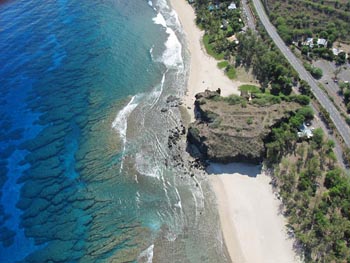 Le cap Homard, La Réunion © B. Cauvin
Le cap Homard, La Réunion © B. CauvinSpread out over 3,500 hectares and five municipalities, Reunion’s Marine Reserve is surrounded by 40 kilometers of coastline and employs 15 staff members. 3,500 fauna and flora species have been recorded, and the recording continues! The Reserve works with a budget of 1.02M€, which is proportional to its functions and existing equipment, co-financed by the State, the Region, the Department and the five municipalities. It is home to 40 surfing spots, 58 diving sites, a range of water sports (kayaking, stand-up paddle...), sea excursion operators and fishermen, fishing is allowed there, but it is closely regulated. By comparison, Saint-Martin’s Reserve covers 3,060 hectares, of which 2,907 hectares are at sea, it employs 7 people and worked with a budget of 420,000€ in 2012, 63% State financed, and 35% self-financed.
240 guards on the shores of France
From the 9th to the 10th of October 2012, Steeve Ruillet joined the 240 coastal guards that are invited every three years to the National Forum of coast guards at Langueux (not far from Saint-Brieuc).
This meeting, organized by the Conservatoire du Littoral and the Rivages Français, is held to discuss the theme of the job of a coast guard and its evolution over the last ten years.
«These exchanges between guards from the mainland and from the overseas territories make us realize that, despite the specificity of our islands, the problems are much the same,» he said.
The Reserve and the Collectivity together in Martinique
In December the Head Ranger, Franck Roncuzzi, and field ranger, Christophe Joe, attended the second interregional meeting of coast guards of the Rivages Français d’Amérique, in Martinique.
This meeting is organized every three years by the Conservatoire du Littoral and the Rivages de France, the national association of administrators of coastlines and lakes.
Franck Roncuzzi and Christophe Joe spoke about the different missions they face on a daily basis whilst exercising their profession.
Saint-Martin was also represented by Michel Hamlet, an officer of the Territorial Brigade of the environment and a coast guard.
He earned this title of coast guard after attending a training program that was offered by the Conservatoire du Littoral for two agents of the Collectivity.
«This meeting that gathered all the ultramarine guards has been very successful and has strengthened our sense of belonging to the same network,» commented Franck and Christophe.
Romain Renoux was invited by the Dutch Caribbean Nature Alliance (DCNA) to attend a regional coordination meeting in Saba on April 24 - 26.
Invited by the RAC-SPAW and the only representative of the French West Indies, the director of the Réserve Naturelle de Saint-Martin shared his professional experiences with the managers of protected sites in the Dutch islands, and in return profited from their knowledge.
He met with Eugene Holiday, the governor of Sint Maarten, and Tadzio Bervoets, director of the Marine Park of Sint Maarten, and congratulated them on their commitment to the protection of natural sites.
They evoked the idea of creating a protected marine zone to the southeast of Sint Maarten.
This zone, which comprises several small islets that serve as havens for marine birds, is located alongside waters already under the jurisdiction of the Réserve on the French side and could serve as important coastal protection for both sides of the island.
This project will figure on the agenda of the next meeting between Saint Martin and Sint Maarten on the subject of regional cooperation.
The DCNA, What is it?
The Dutch Caribbean Nature Alliance (DCNA) serves as an advisory technical and financial help for the six Dutch Caribbean islands - Aruba, Bonaire, Curacao, Saba, Stacia, and Sint Maarten - in terms of environmental protection.
Its mission is to preserve the biodiversity of these islands, on land and at sea, and to help those who run protected sites to have better tools to obtain better results.
Financed by the Dutch Ministry Of The Interior and a Dutch lottery - all lotteries in Holland are obliged to give part of their proceeds to NGOs - the DCNA has real means which benefits the 13 protected zones throughout the Dutch islands.
A look at their website, dcnanature.org, shows that the DCNA is on the cutting edge of environmental protection, from financing the creation of a protected zone to creation of management programs, by way of installing GPS chips on sea turtles to the creation of pedagogical kits for students.
Improving the management of Protected Marine Areas (AMP) by reinforcing regional cooperation is a strong desire for the TE ME UM (Ultra Marine Lands and Seas) networks, the Agency for Protected Marine Areas and CaMPAM, which had invited the managers of the AMP for the Northern Lesser Antilles to participate in a technical workshop for natural sites. This workshop was organized in Saint Claude in Guadeloupe from December 12-16, 2011, and based on the idea of technical collaboration.
The Réserve Naturelle of Saint-Martin was there, as well as the Regional Natural Park of Martinique, DEAL in Martinique and Guadeloupe, the National Park of Guadeloupe, the Réserve Naturelle of Petite-Terre, the Réserve Naturelle of Saint Barth, the Marine Park of Saint-Eustatia and the Marine Park of Sint Maarten.
A member of the Haitian environmental ministry and a member of an environmental association represented Haiti, a nation that is concerned about the decline of marine fauna in its waters and would like to establish an AMP in a fishing zone.
This workshop encouraged fruitful exchanges between the 20 managers and the others present, especially on the art and technique of managing an AMP, how to conduct a negotiation, or interactive management with those who use an AMP, or how to lead an inquiry about the perception of an AMP.
The Agency for Protected Marine Areas accented the marine mammal sanctuary in the French Antilles (AGOA) and the CAR-SPAW (Center of Regional Activities For Specially Protected Area and Species), which works for the protection and the promotion of Caribbean marine milieus, made a presentation.
TE ME UM presented the financing that all managers of natural ultramarine zones should have for training, and the Dutch Caribbean Nature Alliance, based in Bonaire, spoke of the monies it has dedicated to AMPs in the Caribbean and presented certain of its already completed projects. The CaMPAM, whose mission is to support the creation and management of AMPs in the Caribbean and whose network comprises at least 200 of these areas, also shared its experiences.
The workshop concluded with a fieldtrip to the Islets Pigeon, for a session of whale watching, opening the door to a discussion of the activities practiced by private companies, interactions with fishermen, and the AGOA sanctuary.
The Council of French Coasts In The Americas (CRFA) was held on February 9-11, 2012 at Sinnamary in French Guiana.
All of the branches of the Littoral Conservancy in the Americas were there and Pierre Aliotti, vice president of the Collectivity of Saint Martin, was elected president of the CRFA, representing the Northern Islands.
The CRFA members expressed their concerns about the proposition for the modification of a law by the Senate, which requests a transfer of responsibility for the environment, currently the responsibility of the French government, to the Collectivity of Saint Martin. In this context, the coastal council is concerned about the future preservation of the environment and the coastline in particular.
A special motion was adopted with this in mind: “In the local context of string pressure for the urbanization of the shoreline, the coastal council is concerned about the eventual modification of the current regulations of protection for the natural sites in Saint Martin.”
The originality of the underwater trail project in Pinel allowed the Collectivity of Saint Martin to receive the top award from the French Initiative For Coral Reefs (IFRECOR) 2011.
This first IFRECOR competition, promoting coral reefs, was open to all administrations in French Overseas zones during the 2011 yearlong celebration of Overseas France and was designed to honor elected officials who had created a sustainable management program for “their” reefs.
Pierre Aliotti, vice president for the environment, was the winner on December 15, 2012 during the 26th general assembly for the International Coral Reef Initiative, which was held on Reunion Island.
This project was made possible thanks to co-financing from the Réserve Naturelle, the Littoral Conservancy, and FEDER funds.
